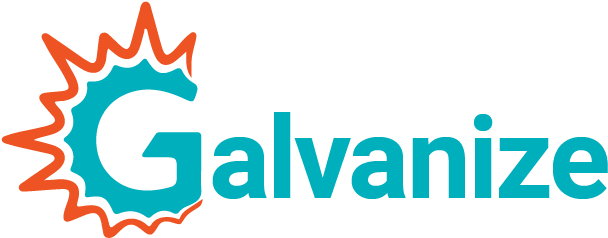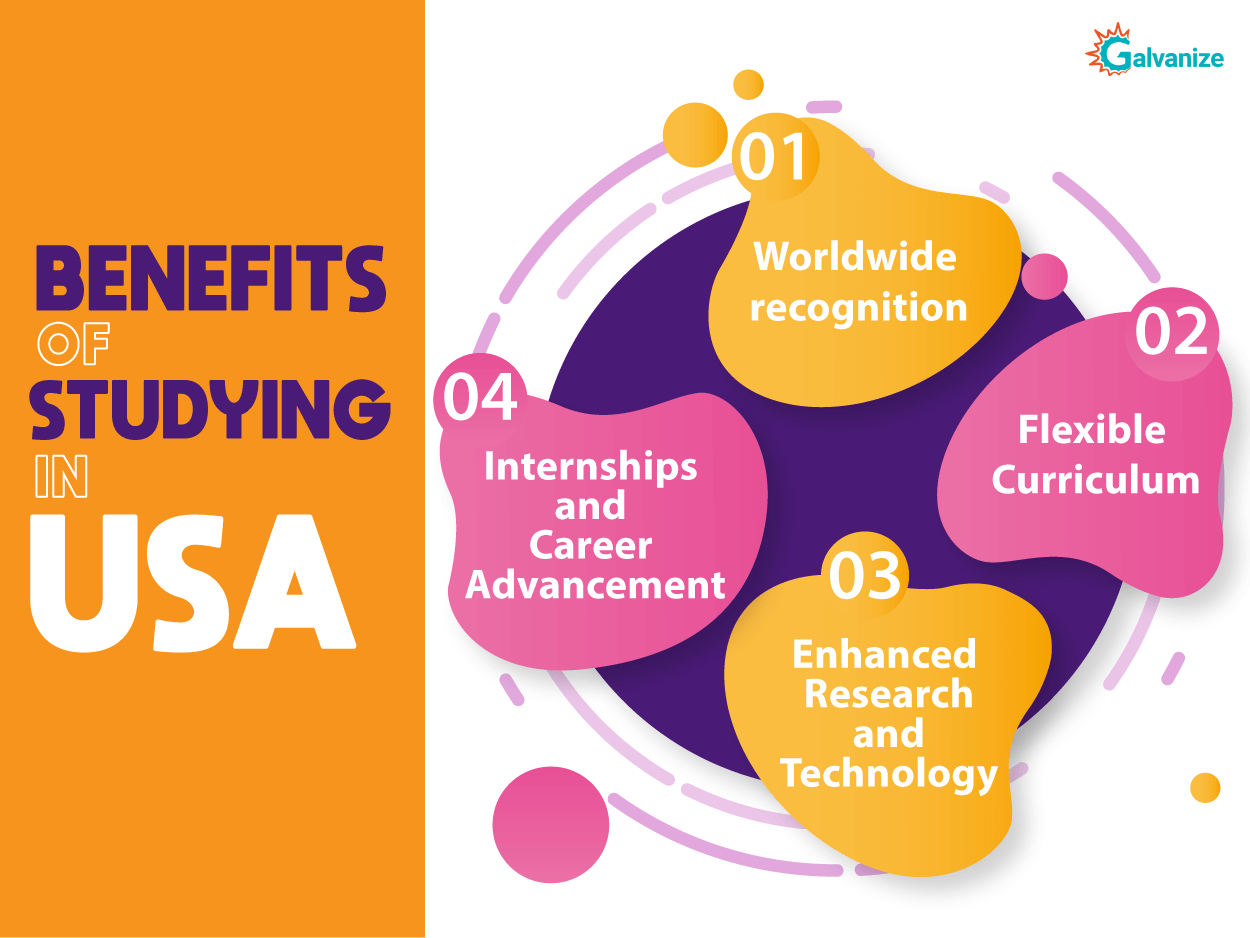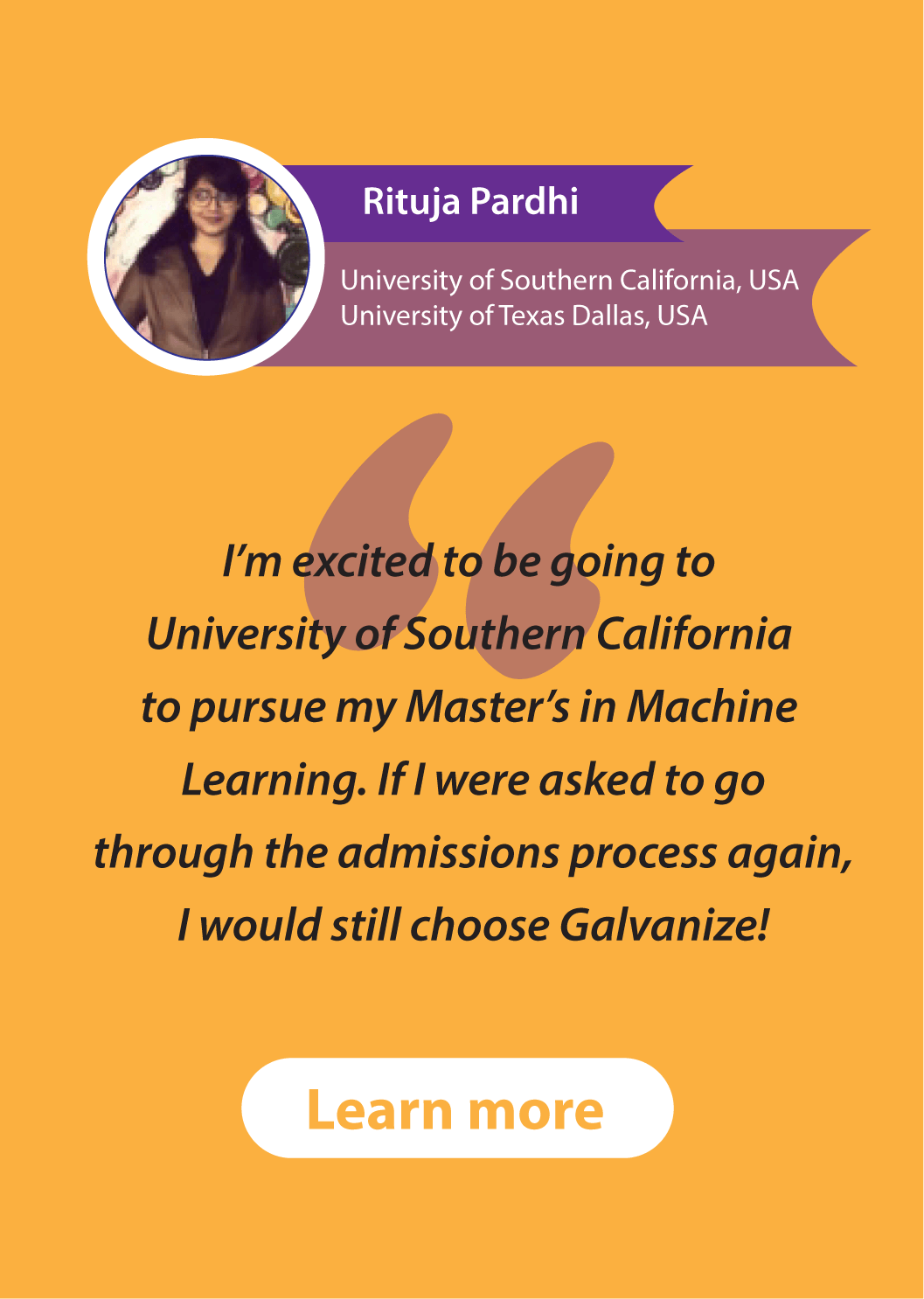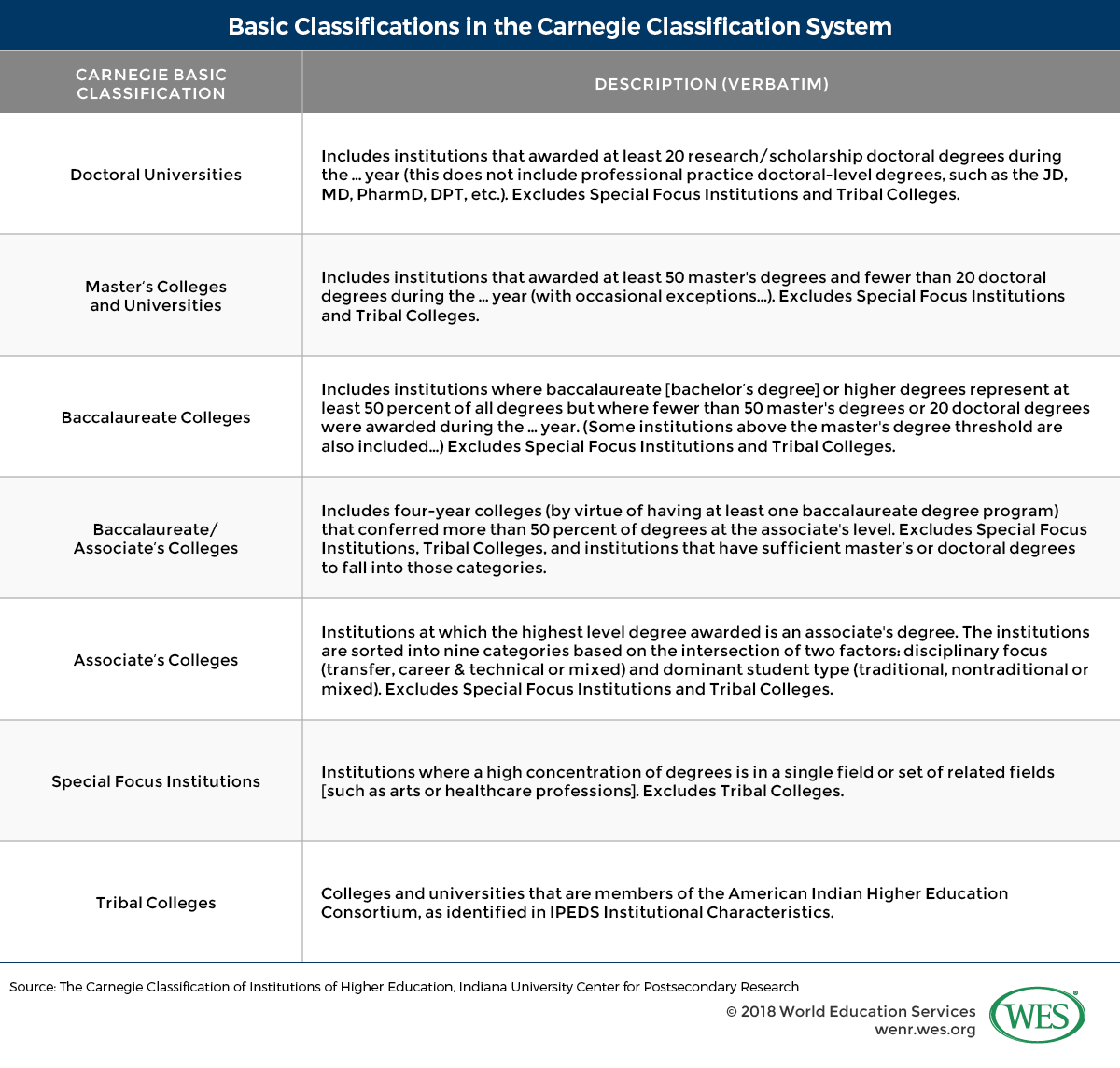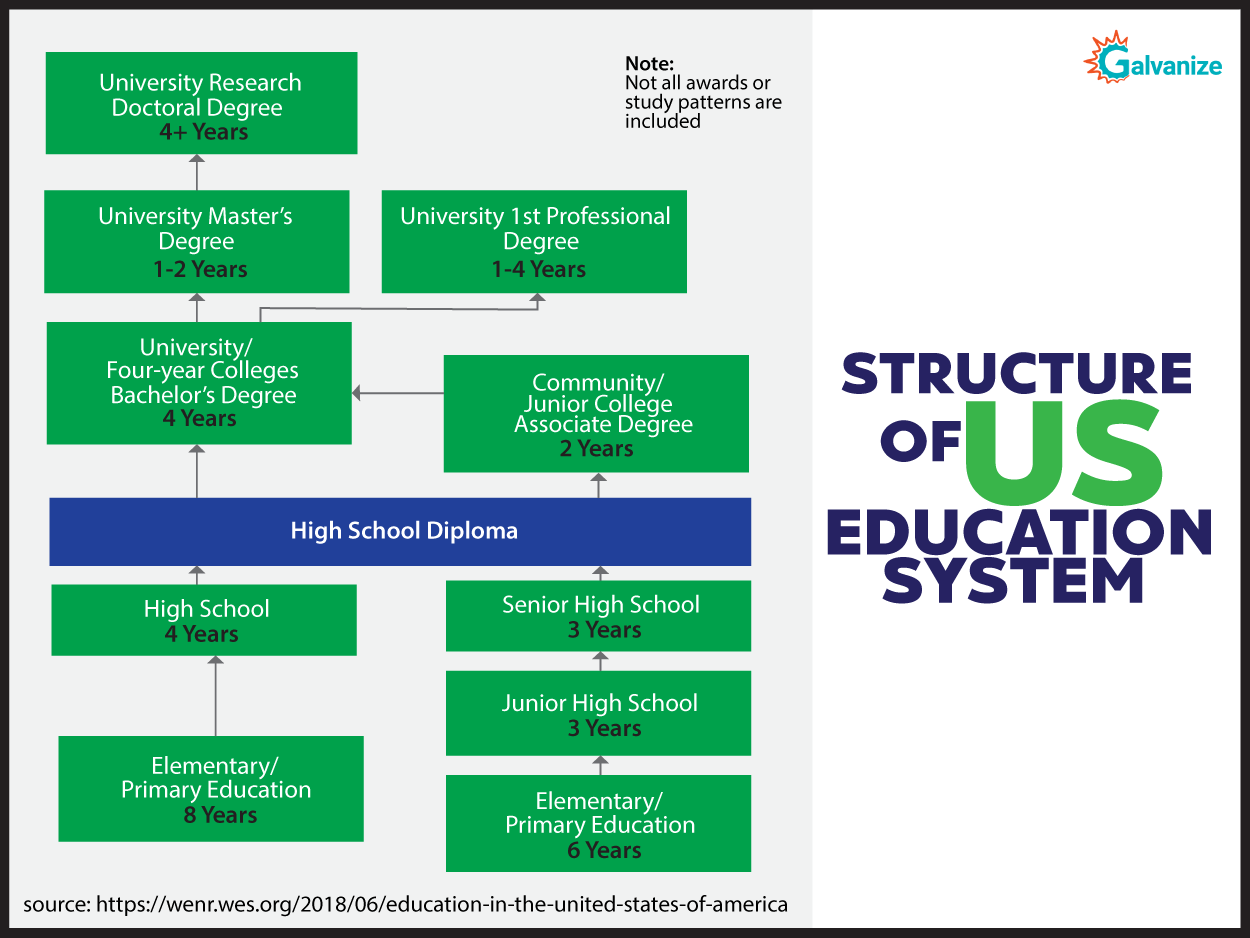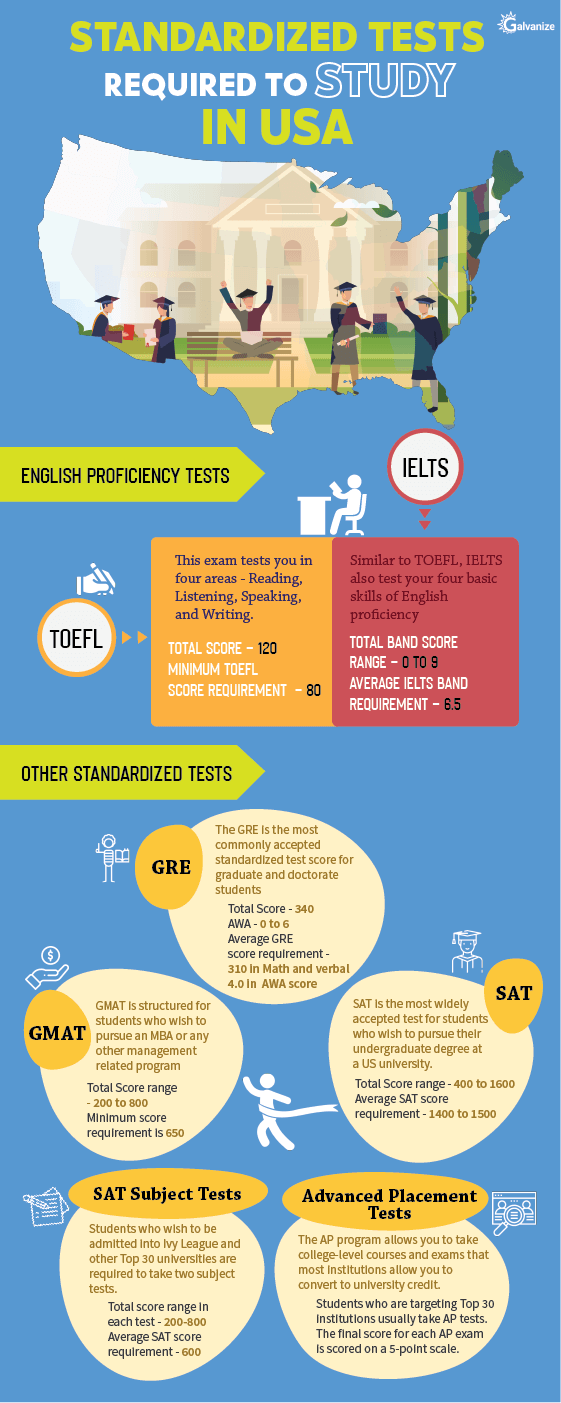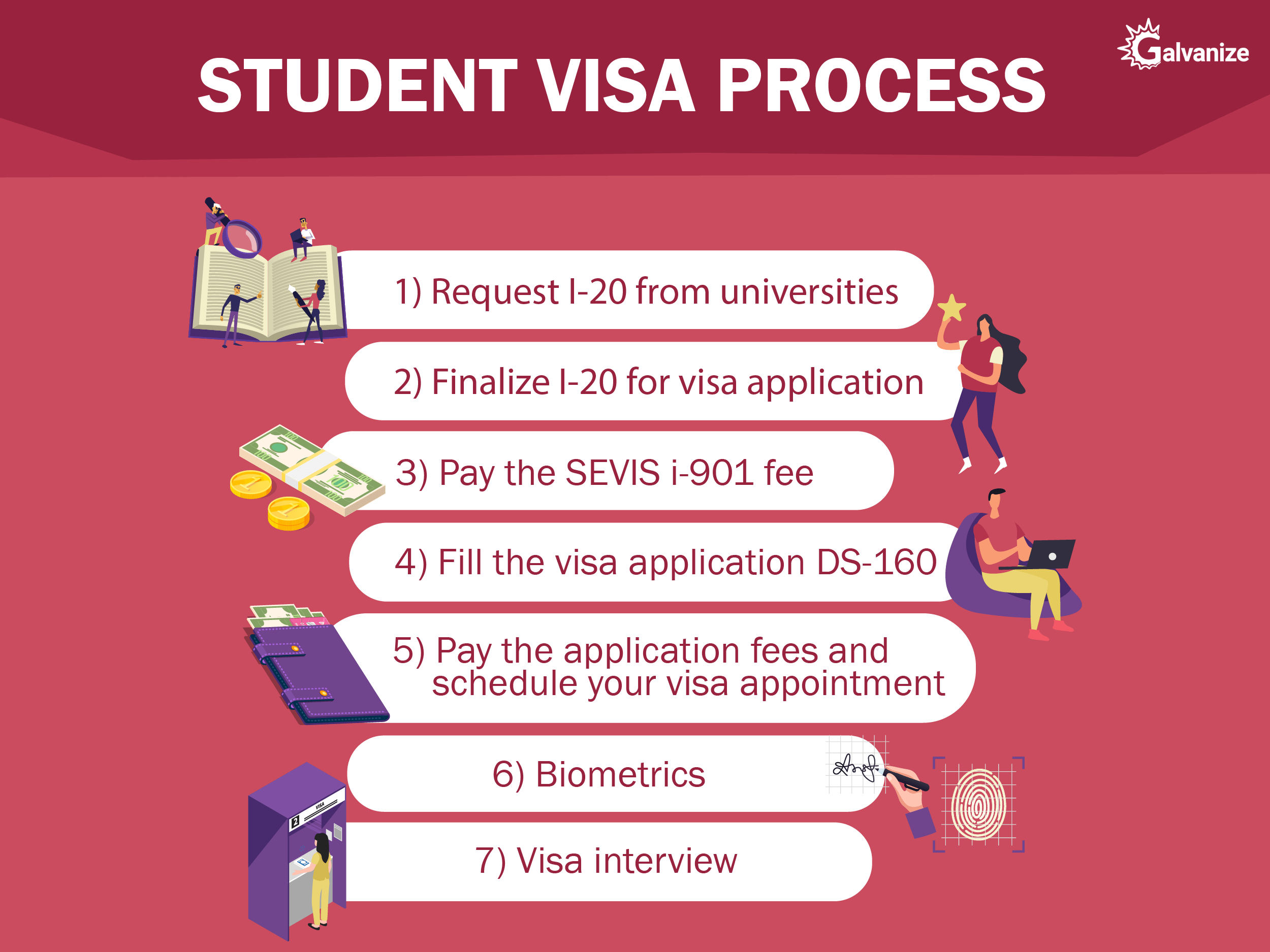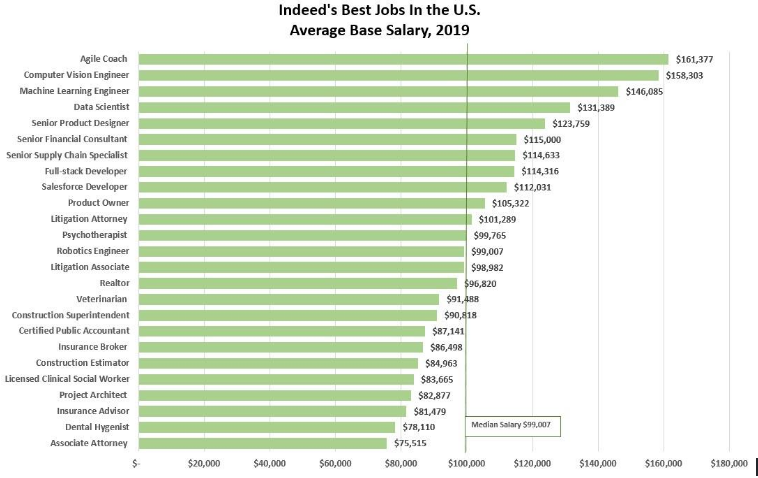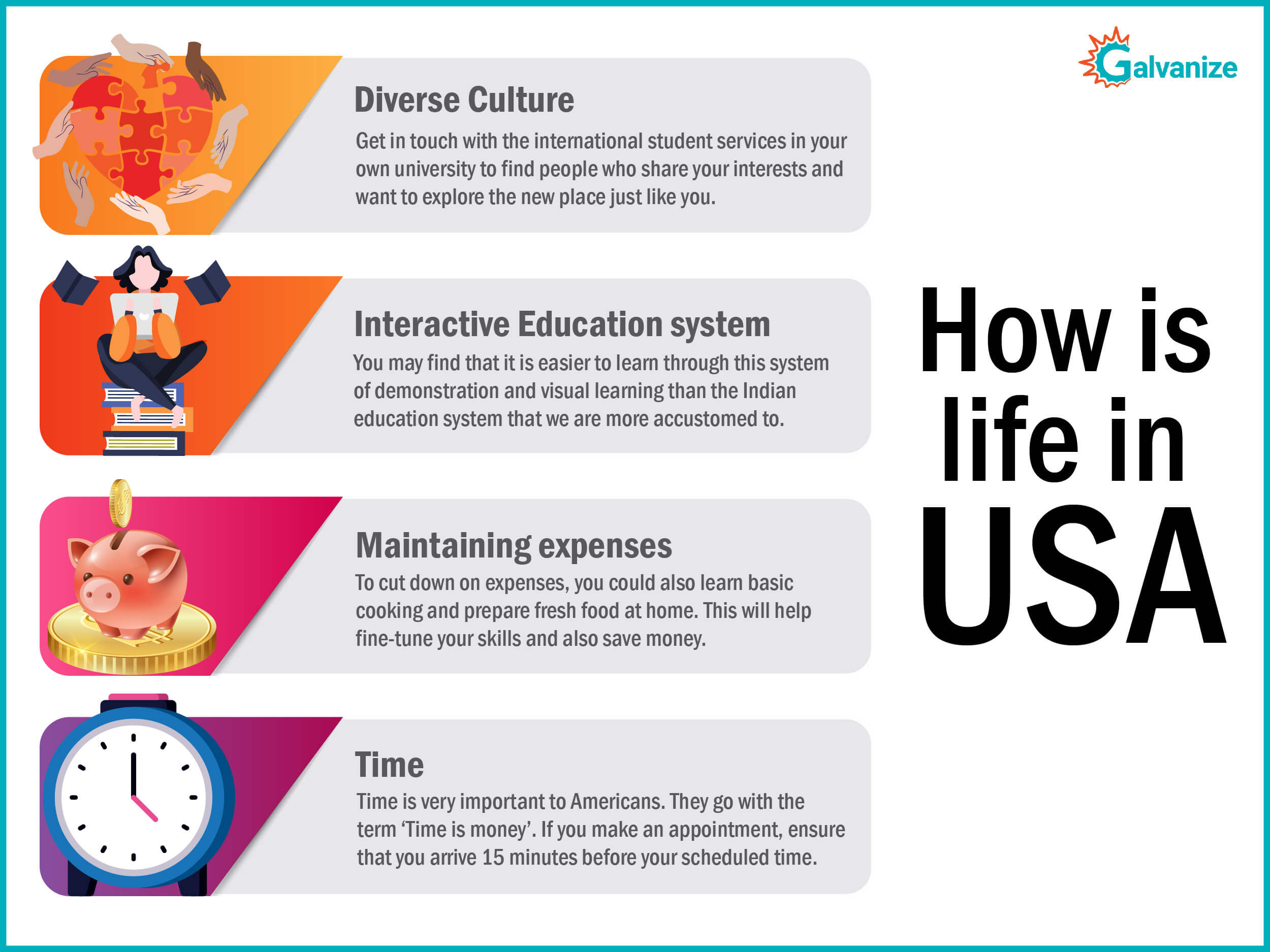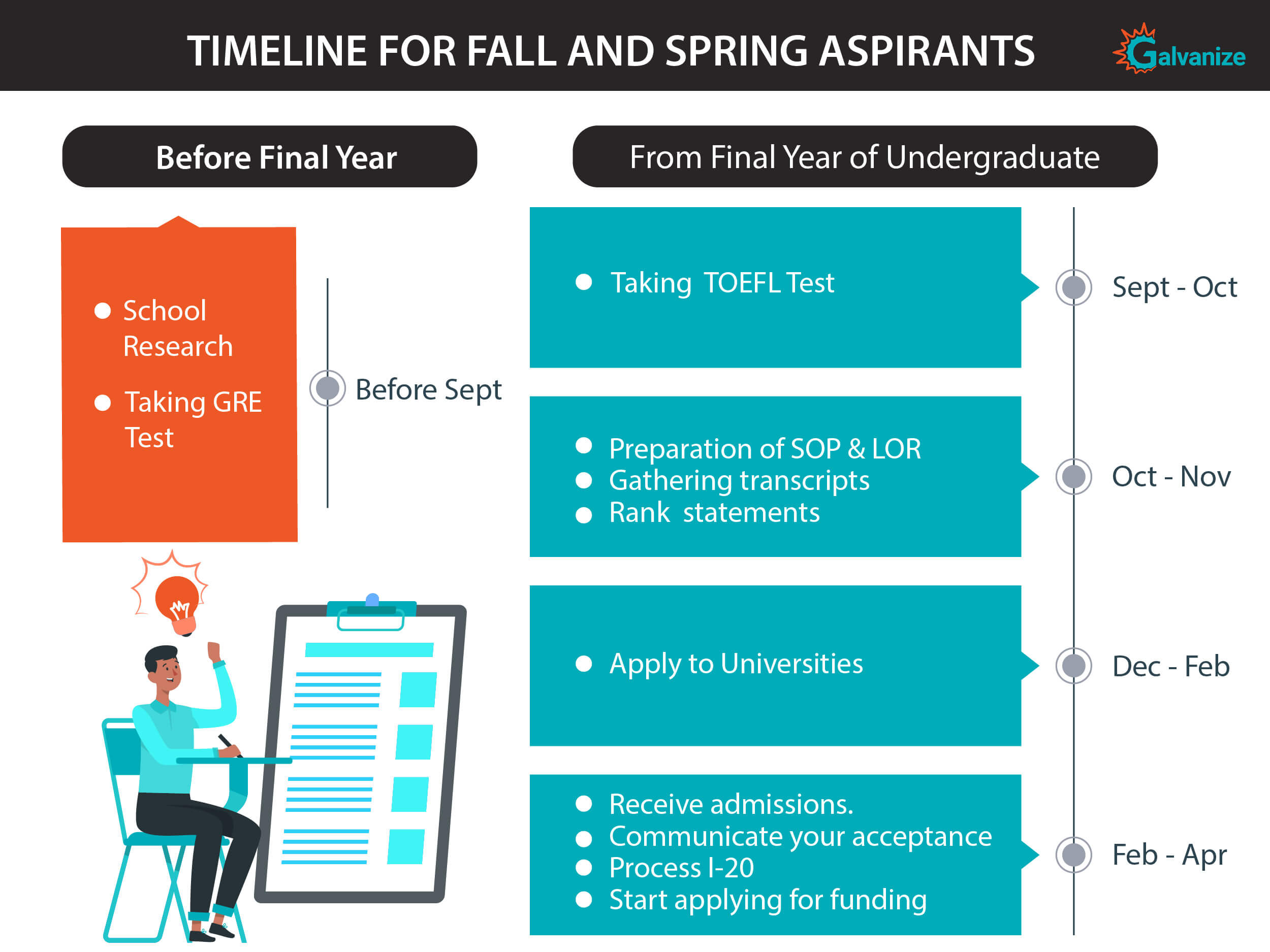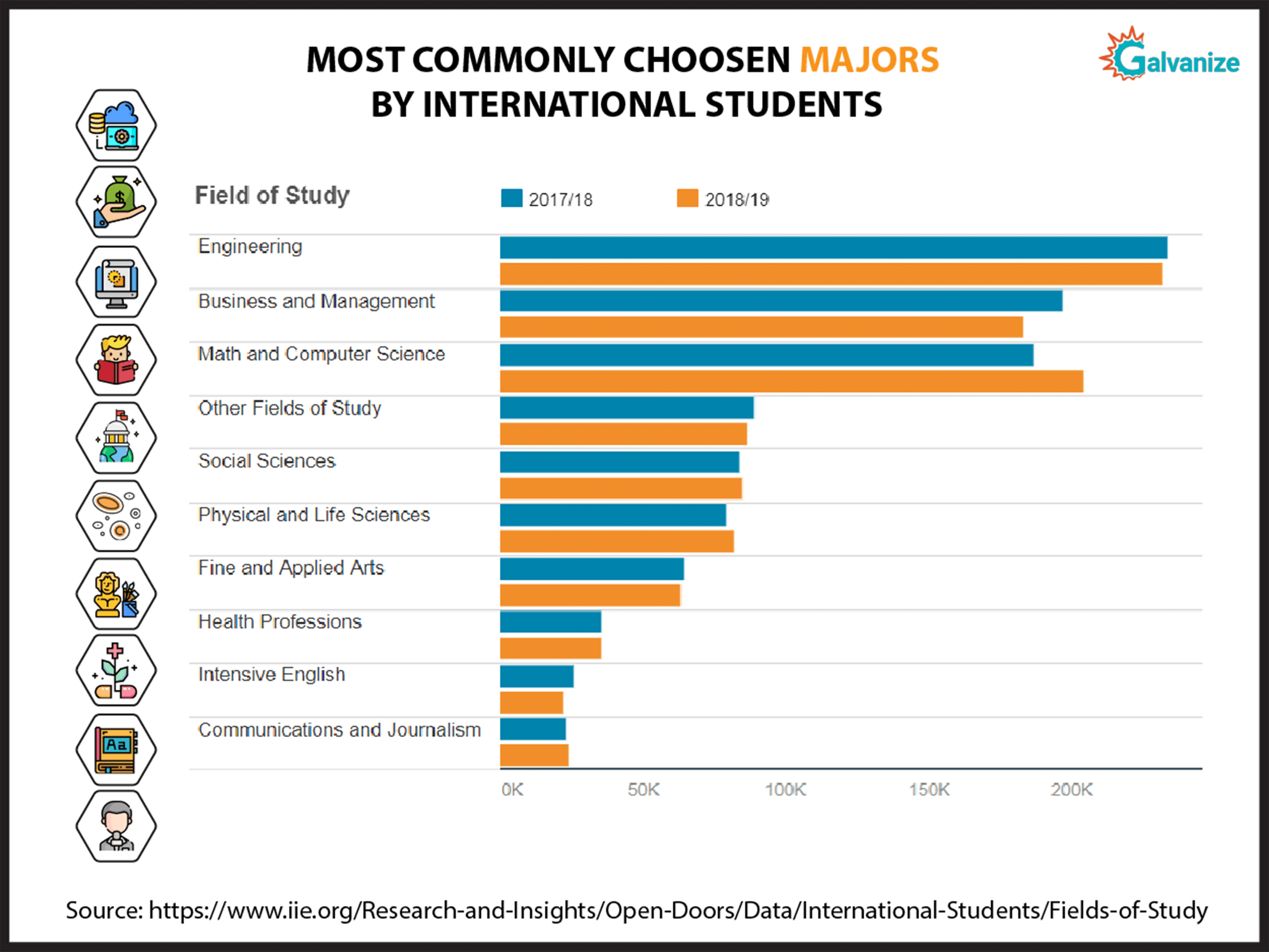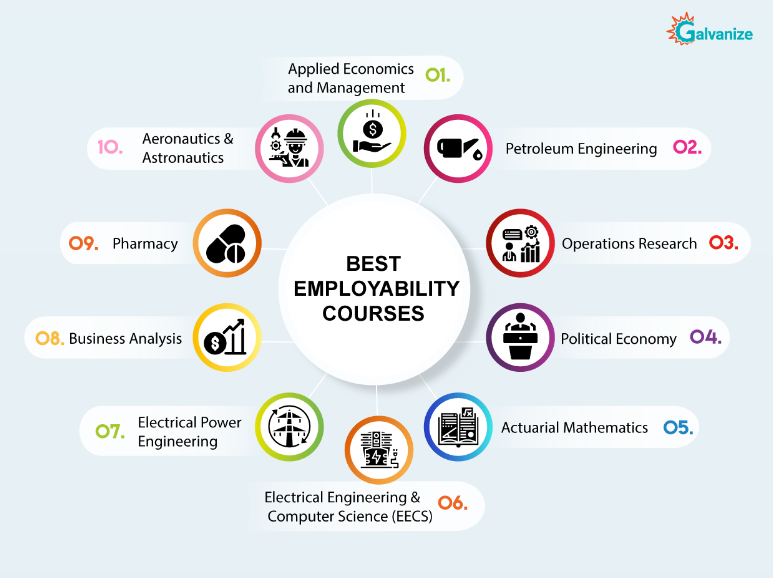Expert Insights on:
Study in USA : Reasons, Eligibility, Cost and Scholarships, Top Universities, VISA and Application Processes (Complete Guide)
In pursuit of the American Dream, each year, over a million students plan to study in the USA with anticipation and optimism. The freedom of choice in how to live, the opportunity to aggregate wealth, own a beautiful home to share with a loving family, to contribute to the ever-burgeoning marketplace of ideas, to pursue a successful career and lead a comfortable life are factors that propel students to seek admissions at US universities that prepare them for a progressive future.
“A basic element of the American dream is equal access to education as a lubricant of social and economic mobility” — Nicholas Kristof, an American journalist.
The factors that constitute the American dream could be yours with the right guidance from Galvanize professionals.
According to the Institute of International Education, the US hosted around 1,095,299 international students in the academic year 2018-2019, contributing $44.7 billion to the country’s economy.
To help you set aside your reservations and doubts, experienced Galvanize professionals address those niggling doubts and fears that may stop you from letting your ambitions soar. It is not a weakness to question the possibilities, but a failing to let those concerns bog you down.
To lift your hopes and ambitions, you will find the information in these pages a great starting point to chart your study abroad plans. With this, the ‘Study in the USA’ dream could be yours.
Table of Contents
Chapter 1 : Why Study in USA?
Chapter 2: Eligibility And Admission Process Requirements
1. What is the Eligibility criteria required to study in the US?
2. Test Prep Requirements
2.1. How to prevent test anxiety?
2.2. What are the test requirements to Study in the USA?
2.3. What exams do I have to appear to study in America?
2.4. What is the required GRE score for top universities in the USA?
2.5. What is the minimum IELTS score required to study MS/MBA in US university?
2.6. How to study in the USA without GRE or TOEFL scores?
3. How do I build my profile for MS in top universities in the USA?
4. Applying to US universities
Chapter 3 : Cost And Scholarship
1. How are you going to finance your education?
2. What are the financial aid options available to study in the US?
2.1. Student Loans
2.2. Scholarships and Grants
3. Is it possible to get a 100% scholarship to study MS in the US?
4. Scholarships for International Students
5. Scholarship competitions for International students
Chapter 4 : Top Universities in USA
Chapter 5 : VISA and Employment Opportunities
Chapter 6 : Campus Life in USA
Chapter 7: Application Process
Chapter 8 : Top Courses in USA
1. Why should you study in the US?
With all the options available, why choose to study in the US? There are different answers to this question, depending on the angle you take. The US has one of the best education systems in the world, and most universities invest in state-of-the-art technologies that provide a wealth of research opportunities.
The curriculum is flexible, and the classroom experience is optimized to allow students to access resources online and have an enhanced virtual experience. This abundance of options attracts students from all around the world, presenting a high diversity ratio and allowing you to gain a global perspective.
What are the benefits of studying in the USA?
The USA is well known for its quality education and the various benefits it offers. According to the US News and World Report, almost 50% of the top 100 Global Universities are in the United States. Following are the advantages of a US higher education:
1. Worldwide recognition
The US education system has always been held for its high regard and the powerful influence it has all over the world. Obtaining a degree from the US is considered a major accomplishment as it is recognized and accredited by various organizations and professional bodies.
Some of the well known accrediting bodies are ABET, AACSB, and ACEN. These programs will help you get qualified for employability anywhere in the world. We will be glad to assist you in finding your dream university and boost your career to the next level. Contact us to give wings to your dreams!
2. Flexible Curriculum
The curriculum, as well as the flexibility provided, makes the US education system stand apart. Courses offer the right measure of core and elective courses that are designed to meet the students’ development needs to upskill for future employability.
The theoretical and applied nature of the teaching methodology makes learning interesting, as well as exciting. Students have the flexibility to take the required courses and then choose from a wide array of related subjects to complete their formal degree program.
They can choose to take courses from their own department or even from other departments to suit areas of interest. This ability to customize your curriculum to your needs makes the education system more appealing than the traditional top-down structure of other curriculums, allowing you to be at the cutting edge of your discipline.
3. Enhanced Research and Technology
Home to more than 250 Nobel laureates, the universities in the US are well known for their remarkable research contributions over the years. To remain competitive in sectors shaped by technology, US funding for Research and Development increases each year. Investment in R&D is indicative of the country’s economic power.
According to Forbes magazine (Jan 20, 2020),
Total global R&D expenditure expanded threefold between 2000 and 2017, rising from $722 billion to $2.2 trillion, and the United States is a global leader in R&D, investing more than US$545 billion in 2017 alone.
Gaining access to the most cutting edge research resources at US universities will help students gain a spot at the forefront of innovation in their field.
4. Internships and Career Advancement
Internship programs or Co-op programs are offered by many universities and colleges in the United States to kickstart a student’s professional career.
Most students utilize the Curricular Practical Training (CPT) option to obtain internships while still enrolled at the university. This allows students to take advantage of the hands-on experience and to get access to better paying jobs after they graduate.
While international students may choose to return to their home country or remain in the US to work full time, their US education will definitely boost their career success. Career Services on the university campus conduct Job Fairs for students to showcase their talent to potential recruiters.
They offer guidance on resume building and provide students access to a database of recruiters and professional alumni networks to support students’ career aspirations.
2. US Education System Vs Indian Education System
The Indian Education system has a traditional outlook towards imparting learning with a strong emphasis on Science and Math. The curriculum is structured around a one-year academic term concluding with annual year-end examinations. It is currently undergoing a number of significant changes.
There are a variety of agencies that recognize and oversee academic institutions and programs in India.
They are UGC, the AICTE, the Distance Education Bureau, and professional regulatory bodies like the Medical Council of India or the Pharmacy Council of India, some of which have overlapping responsibilities.
Due to R&D spending constraints in India, the scope for research and innovation remains relatively low.
This is evidenced by the lack of an inquiry-based approach to learning or self-directed learning across educational sectors limiting the innovation potential of Indian students and faculty to address the most cutting edge, global challenges through a convergence of knowledge from the science, technology, arts, and humanities.
The US educational system is well known for its academic excellence, cutting edge technology, generous access to R&D opportunities, a wide variety of educational options, flexible curriculum, and hands-on training through a variety of work-study options for an enriching student life.
The US Education institutions are accredited on a national or regional level by independent accrediting bodies such as AACSB for business, and ABET for applied and natural science, computing, engineering, and engineering technology.
The campuses are sprawling and beautiful with start-of the art infrastructure including libraries with up-to-date collections, well-funded student clubs, adequate health facilities, career support services, recreation facilities, and additional support for international students with the dedicated office staff.
Most importantly, US graduates are best poised to tackle some of the most pressing challenges of their times and are employable anywhere in the world.
3. How is the education system in the USA?
There are different types of Higher Education Institutions (HEIs) in the country.
Public universities, also known as state universities, are those that are funded by the state and, therefore, are inexpensive for those who are residents of that state. However, this subsidy is not applicable to international students.
Private universities, on the other hand, are not supported by the government, and the tuition is considerably higher for both native and international students.
Ivy League schools are a group of eight elite universities that offer a wide range of programs from medicine, to law, to liberal arts. But considering their elite status, the competition is very stiff, and the fee, needless to say, is pretty high.
There are also some colleges that focus on a particular type of program.
Liberal Arts colleges are those that concentrate on promoting the arts, while Technical Schools primarily focus on technical and professional courses.
Community colleges aim to prepare their students for the workforce, and as such, offer a variety of degrees, certificates, and diplomas.
It includes community colleges, Liberal Arts colleges, Historically Black Colleges and Universities (HBCUs), Tribal colleges, Master’s colleges and universities, and Doctoral- granting universities. The type and status of an institution can be understood by using the Carnegie Classification of Institutions of Higher Education.
The USA is also known for its Ivy League colleges, which are the most famous top-ranked private research universities in the world. The Ivy League is a group of eight historic private universities in the northeastern United States. The eight universities in the group are:
The Ivy League was formed as an athletic association in the 1950s. The term Ivy League was first used when these eight institutions became part of the NCAA (National Collegiate Athletics Association).
The name Ivy League has become synonymous with prestige and privilege as well as strong academics. These universities have groomed many US presidents and other major U.S. and world leaders, as well as leading intellectuals, artists, and Nobel laureates, among others.
The Structure of the US Education System is as follows:
4. Are US universities really better than Canadian universities?
Both US universities and Canadian universities are on par when it comes to the international education provided. However, there have been recent changes in the number of students getting enrolled in Canadian universities. In 2018, more than 720,000 international students entered into Canada to pursue their higher studies.
There are three reasons why International students consider opting for Canada as their destination. They are:
- Increased international student recruitment
- Expedited study permit, work and residency opportunities
- Scholarships
- Excellent healthcare policy
Source: https://www.iie.org/en/Research-and-Insights/Project-Atlas/Explore-Data
However, US universities are better known for their research as well as funding opportunities. Based on a report by The Global Innovation Index, the following facts substantiate the same.
- No. 1 Public and Private R&D Expenditures, with over $510B being spent on research and development.
- No. 3 in Global Innovative Index rating (2019).
- Approximately 18 billion in Global App Downloads produced by local companies (2018).
As a student, your thoughts would be – what parameters should I consider while choosing between US and Canadian universities? You could consider the quality of education, courses offered and its average salary, tuitions and scholarships, university ranking, lifestyle and expenses, post-study work permit, and career opportunities.
5. Factors to consider when choosing a University to Study in the USA?
Choosing the right university is one of the biggest decisions to make when it comes to education. While the process can be overwhelming, it would be great to consider several factors to make the task less daunting. You could consider the following factors:
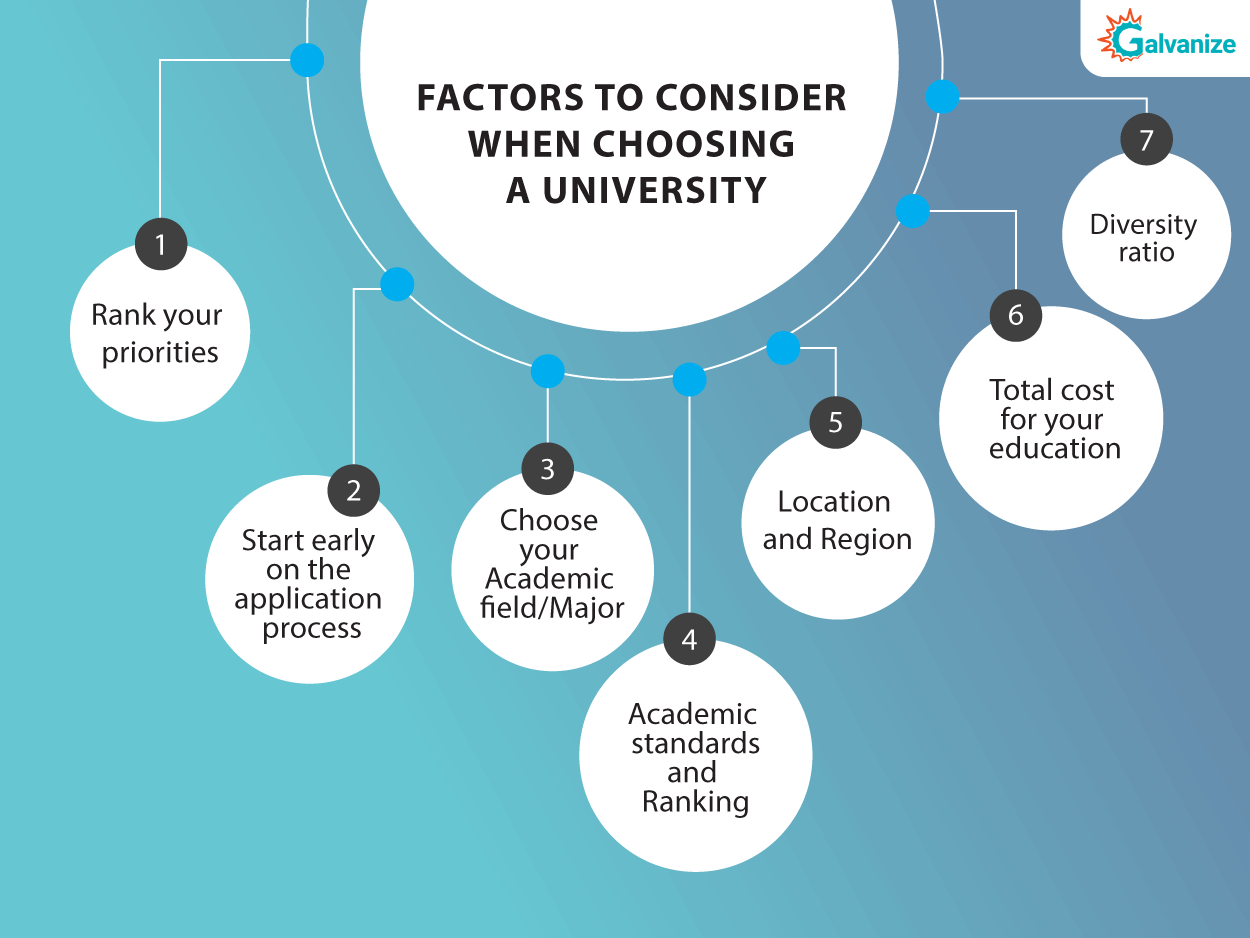
1. Rank your priorities
Take the time to weigh the pros and cons of a particular school when you are working on choosing the right college. The ranking is important but more than that, you will have to see if the program will meet your developmental needs.
2. Start early on the application process
It is important to complete all tests and gather all documents to apply for universities well ahead of time. Experts suggest starting the process 10 to 12 months in advance for graduate studies, and at least 2 – 3 years in advance for undergraduate studies depending on your university target.
3. Choose your Academic field/Major
Check to see where your choice of academic major is provided. While most universities offer popular majors, only a few would provide specialized majors such as marine biology or archeology. It is important to go through it in detail.
4. Academic standards and Ranking
Admissions to universities are highly competitive, especially for international students to study in USA. You can talk with your study abroad counselors to understand your probability of being admitted to your selected school. You can reach out to us to guide you through the admissions process.
5. Location and Region
Geographic region and location can be highly influential when choosing a university to study in USA. Where you choose to study would affect your overall experience and provide you access to professional opportunities. Some students might prefer to live and study in city areas while others might choose rural areas.
6. Total cost of your education
Understanding your tuition, as well as living costs to study in USA, will help you narrow down the university of your choice. This information will be available on the university website. Private colleges and universities have higher tuition costs than public universities. Understanding your budget to complete your coursework will help finalize the university.
7. Diversity ratio
For many international students, the diversity ratio is a factor of concern. As of recent years, most US universities have taken efforts to increase their diversity index.
While culture shock is still an experience most international students undergo, a culturally diverse environment can help to significantly lessen the effect, knowing that your experience is not isolated. Furthermore, a lot of US universities conduct orientation programs and other events to help foreign students adjust to the new campus.
These are the universities in the US that host the largest number of international students (IIE):
| Rank | Institution | Total International Students |
|---|---|---|
| 1 | New York Univeristy | 19,605 |
| 2 | University of Southern California | 16,340 |
| 3 | Northeastern University - Boston | 16,075 |
| 4 | Columbia University | 15,897 |
| 5 | University of Illinois - Urbana - Champaign | 13,497 |
| 6 | Arizona State Univeristy - Tempe | 13,324 |
| 7 | University Of California - Los Angeles | 11,942 |
| 8 | Purdue University - West Lafayette | 10,943 |
| 9 | University of California - San Diego | 10,652 |
| 10 | Boston University | 10,598 |
| 11 | University of California - Berkeley | 10,063 |
Source:https://www.iie.org/Research-and-Insights/Open-Doors/Data/International-Students/Leading-Host-Institutions
6. Where should you study in USA?
The table given below details the top ten states in the US that have the largest population of international students (Migration Policy Institute). This table will be useful to you if diversity of the region is important to your choice of destination.
| State | International Students | Total Immigrant Population | ||
|---|---|---|---|---|
| Number | Share of US Total (%) | Number | Share of US Total (%) | |
| United States | 10,79,000 | 100 | 4,37,39,300 | 100 |
| California | 1,57,000 | 14.5 | 1,06,77,700 | 24.4 |
| New York | 1,18,000 | 11 | 45,36,100 | 10.4 |
| Texas | 85,000 | 7.9 | 47,29,900 | 10.8 |
| Massachusetts | 63,000 | 5.8 | 11,23,900 | 2.6 |
| Illinois | 52,000 | 4.8 | 1,783,500 | 4.1 |
| Pennsylvania | 51,000 | 4.7 | 8,70,900 | 2 |
| Florida | 46,000 | 4.2 | 42,36,500 | 9.7 |
| Ohio | 39,000 | 3.6 | 5,13,600 | 1.2 |
| Michigan | 34,000 | 3.2 | 6,62,300 | 1.5 |
| Indiana | 31,000 | 2.8 | 3,49,200 | 0.8 |
| Other States | 4,03,000 | 37.3 | 1,42,55,700 | 32.6 |
Source: https://www.migrationpolicy.org/article/international-students-united-states
You might prefer a specific location based on the industry concentrated in the area to study in USA. For instance, California has the largest population of international students as it is home to Silicon Valley, abounding with global technology companies.
New York City is another popular destination for international students thanks to Wall Street, making it one of the largest international Financial Centres. Others may choose a location to study in USA, based on proximity to family and friends, and that is very reasonable as they provide a strong support system.
But climate could also be a factor to consider. While the country generally has a continental climate, some regions are colder than others, and some are relatively warm all year round.
If you find it impossible to adjust to certain temperatures, you should choose carefully. Moreover, the culture in each of the country’s fifty states is different and unique, so it is important to select a location that you are comfortable with.
Chapter 2 : Eligibility and Admission Process Requirements to study in USA
Table of Contents : Requirements to study in USA
1. What is the Eligibility criteria required to study in the US?
2. Test Prep Requirements
2.1. How to prevent test anxiety?
2.2. What are the test requirements to Study in the USA?
2.3. What exams do I have to appear to study in America?
2.4. What is the required GRE score for top universities in the USA?
2.5. What is the minimum IELTS score required to study MS/MBA in US university?
2.6. How to study in the USA without GRE or TOEFL scores?
3. How do I build my profile for MS in top universities in the USA?
4. Applying to US universities
1. What is the eligibility criteria required to study in US?
US Universities are reputed all over the world for the quality of its education. As a result, students from across the nations apply to various universities in the US to secure a world-class education.
There are several criteria that the students need to meet in order to apply:
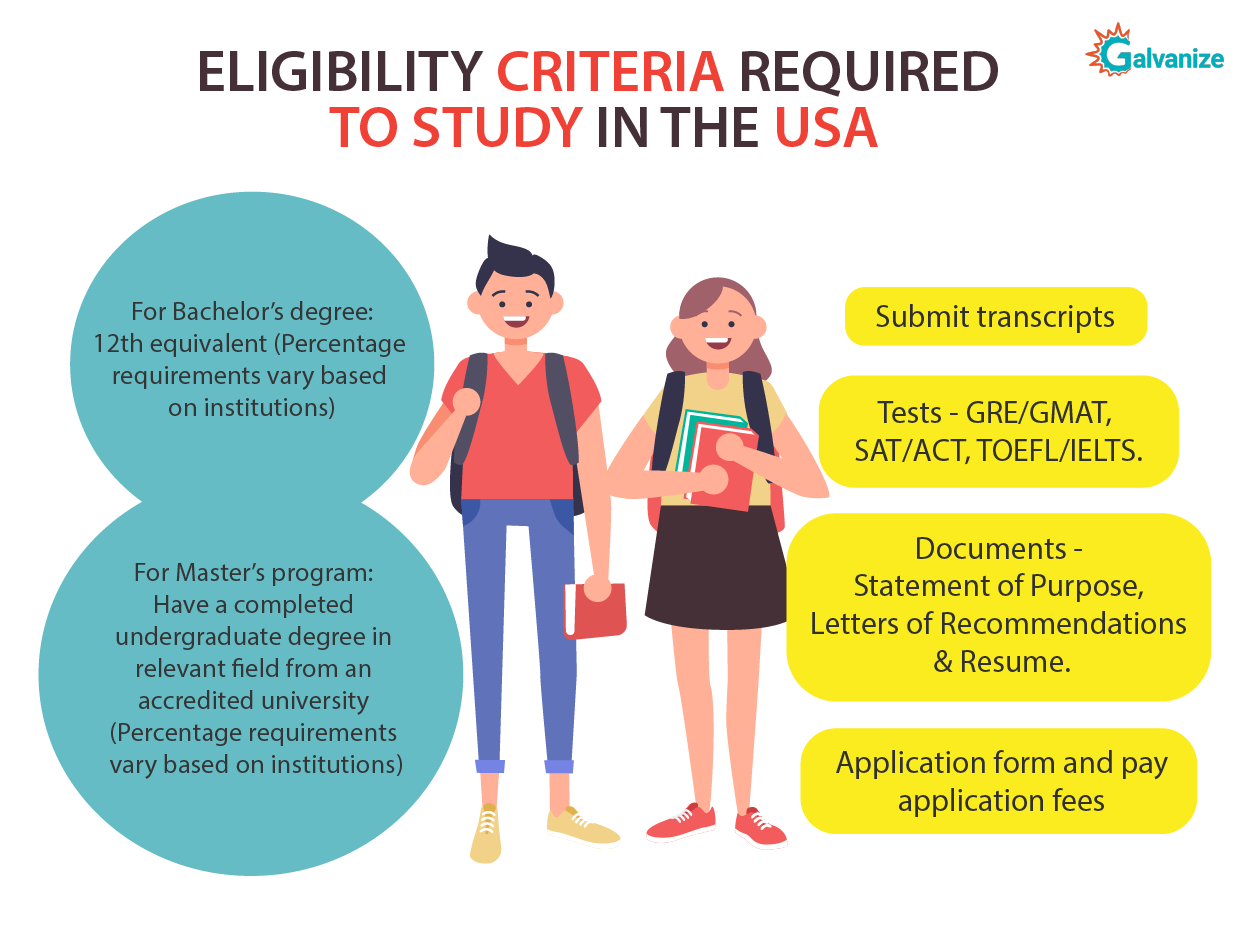
1. Qualification for Bachelor’s degree: A strong college preparatory curriculum in high school grades 9 – 12. Transcripts of coursework and grades are required for all years of secondary school study and should list the subjects studied each year and the mark or grade of proficiency earned.
2. Qualification for Master’s program: An undergraduate degree in a relevant field from an accredited university that grants 4-year degrees. Semester by semester transcripts must be submitted.
3. Complete the necessary tests like GRE/GMAT, SAT/ACT, TOEFL/IELTS. These test scores should be reported to the respective universities directly through your testing agency.
4. Complete relevant documents such as Statement of Purpose, Letters of Recommendations, Resume.
5. Complete the application form and pay application fees.
6. Provide financial documents with your application, if required.
7. Attend Interview, if applicable.
8. Select courses in arts and architecture will have portfolio requirements.
2.1. How to prevent test anxiety?
As Dr. Benjamin Spock said, “Trust yourself, you know more than you think you do.”
This applies to tests as well. Test anxiety is something that students all across the world suffer from, and it’s fundamentally built on a fear of failure.
Many students find that they are able to perform well when attempting mock tests or practice tests in a comfortable environment, but inevitably perform poorly when stuck in a formal exam environment.
This does not mean that the student is incapable of performing well in exams or that they lack the skills they are being tested on. They are simply suffering from test anxiety.
Stress levels rise as the day of the test approaches, and the paralyzing anxiety ultimately reduces the student’s performance. While it is natural, it is also destructive, as it makes you feel mentally and physically stressed, leading to nausea, headaches, shortness of breath, and even panic attacks.
These symptoms result in reduced concentration, and “blanking out,” where the intense stress causes a student to forget all that they have learned.
You can prevent test anxiety, by following a few tips:
1. The key to overcoming test anxiety is to stay calm and be prepared. Remember that there are hundreds of other students who are also taking the test and are probably going through the same thing.
2. The best you can do is start your preparation as early as you can. You can never start too early. Most students who suffer from test anxiety usually start too late to prepare for their exams.
3. Attempt mock tests and practice tests online. There are several mock tests available that aim to recreate the exam. Attempting several mock tests will not only help you gain practice on the exam syllabus but will also train you for the actual exam setting. Galvanize also provides mock tests as part of our study plan, to help familiarize you with the structure of the exam.
4. If you are taking an English proficiency test where they will test your speaking skills, make sure that you practice speaking loudly, clearly and confidently.
Even if you have great content, if you are unable to convey it properly, you will have failed in your attempt. There are several online resources, including the mock tests provided by Galvanize, to help you prepare for these.
5. Don’t cram until the last minute. Many students try to study until the minute they are required to enter the test center, but this habit only serves to increase their anxiety and confuse them further. Do not attempt to learn anything new on the day of the exam.
6. Get enough rest. Lack of sleep can also cause you to lose concentration and perform poorly on the exam. The night before your test, make sure you get plenty of sleep and wake up early to be on time for your exam.
7. Familiarize yourself with the rules listed on the exam website. There are certain security checks and verification procedures that will be done before you sit for the exam. Go through the regulations and make sure you arrive at the center with ample time to complete the process.
8. Most importantly, do not worry about your result or the score that you will get. Remember, you can always retake the test if required, so focus on doing your best and giving your best performance.
2.2. What are the test requirements to Study in US?
English Proficiency Tests
There are several tests you can attempt to prove your English proficiency as well as your aptitude skills. Following are the tests that are widely accepted by universities and easily accessible to students worldwide:
1. TOEFL
The Test of English as a Foreign Language is based on American English and tests you in four areas – Reading, Listening, Speaking, and Writing. The exam is scored out of a total of 120 marks, and the minimum TOEFL score requirement for most US university admissions is 80.
It takes about 3 hours to complete the TOEFL test. Click here to know how you can achieve a high score in TOEFL Exam.
2. IELTS
This test also tests you on the four basic skills of English proficiency. The IELTS follows a 9-band scale for scoring, where students will receive an individual score for each section along with an overview score. All scores are between 0-9.
The average IELTS band requirement for US universities is 6.5. The total test time is 2 hours and 45 minutes. Learn more about how you can achieve a top score.
This table offers a comparison of the two tests to help you decide which test will be better for you.
| TOEFL | IELTS | |
|---|---|---|
| Administered by | Education Testing Service (ETS) | British Council, the University of Cambridge EOSL Examinations, and IDP |
| Uses | U.S. English | U.K. English |
| Sections | 1. Reading 2. Listening 3. Speaking 4. Writing |
1. Reading 2. Listening 3. Speaking(in person) 4. Writing |
| Scores | Total 0-120 Points | Between 0-9 with half scores |
| Cost | U.S. $160-$250 | U.S. $205 depending on location |
Other Standardized Tests
1. GRE
The Graduate Record Examinations is the most commonly accepted standardized test score for graduate and doctorate students who wish to study in the US. It tests students on three skills – Verbal Reasoning, Quantitative Reasoning, and Analytical Writing (AWA).
The test is scored out of a total of 340 marks, where the Verbal and Quantitative sections are each scored between 130-170. The Analytical Writing section is scored separately, on a scale of 0-6.
The minimum GRE score requirement differs from university to university, but an aptitude score above 310 and an AWA score of 4.0 is the average requirement. Prepare well for these exams, by using preparation material and resources from reliable, proven sources. Galvanize GRE prep material assigns you a study plan with structured Mock Tests to prepare for the exam and provides feedback on your performance to help you improve. You can even take a free GRE sample test and get a free profile evaluation.
2. GMAT (MBA)
As the name suggests, the Graduate Management Admission Test is structured for students who wish to pursue an MBA or any other management related program.
This exam tests the student on four areas – Quantitative Reasoning, Verbal Reasoning, Integrated Reasoning, and the Analytical Writing Assessment.
The test is scored on a scale of 200-800, and the minimum GMAT score requirement for most US universities is 650. There are many universities that will accept the GRE in lieu of the GMAT.
3. SAT (Undergraduate)
The Scholastic Academic Test is the most widely accepted test for students who wish to pursue their undergraduate degree at a US university. The SAT tests you on four skills – Reading, Writing and Language, Math, and an Essay.
It is recommended that students who take the SAT, attempt the essay. The total score range for this test is 400-1600, and on average, top universities accept a SAT score between 1400-1500. Check out this complete guide to the SAT exam.
4. SAT Subject Tests (Undergraduate)
Students who wish to be admitted into Ivy League and other Top 30 universities are required to take two subject tests. While there are many universities that don’t require it, it is recommended for scholarship consideration.
There are 20 SAT subject tests in five subject areas and each test is scored on a scale of 200-800. Please visit the College Board website for a list of subjects. While the minimum SAT score and percentile ranks differ for each subject, an average SAT score will be 600 and above.
5. Advanced Placement Tests (Undergraduate)
The AP program allows you to take college-level courses and exams that most institutions allow you to convert to university credit. These tests also prove your proficiency in a particular subject, which may allow you to skip introductory courses in that subject in college.
Students who are targeting Top 30 institutions usually take AP tests over and above their high school curriculum. The final score for each AP exam is scored on a 5-point scale.
Once you’ve decided on which test to take, you will need to book your slot. Make sure that you give yourself ample time to prepare. The standardized test scores reflect your aptitude for the curriculum and assess your logical and critical reasoning skills.
It is important that you prepare well and score maximum marks, to increase your chances of being accepted to your targeted university. For guidance regarding the right test for you, please contact us.
2.3. What exams do I have to appear to study in America?
If you are applying for an undergraduate program to study in USA, you will be required to take the SAT.
Graduate students seeking to pursue MS or MA and Ph.D. generally take the GRE. Students applying for management courses attempt the GMAT or GRE.
To prove your English proficiency, all students take either the TOEFL or the IELTS. Both exams are widely accepted.
2.4. What is the required GRE score for top universities in the USA?
To apply to top graduate programs in the US generally a GRE score of at least 320 is considered good. In other words, you would need to score around 160 or above in both the Quantitative and Verbal sections. Your AWA score would need to be 5.0.
2.5. What is the minimum IELTS score required to study MS/MBA in US university?
The IELTS is widely accepted by over 3000 US institutions. The minimum IELTS score for an MS or MBA student is 6.5 with no subsection below 6. A list of US universities that accept the IELTS could be found here.
2.6. How to study in the USA without GRE or TOEFL scores?
There are several programs that will waive the GRE requirement. However, you will need to have a good GPA in college. The English Proficiency Score cannot be waived. Students may present either TOEFL or IETLS for English proficiency.
3. How do I build my profile for MS in top universities?
The graduate admissions process is very selective. First, students have to meet the minimum eligibility requirements for the graduate program and university.
Any incomplete applications are likely to be disqualified. The review process is holistic and the applicant’s test scores, academic performance, work experience, letters of recommendation, statement of purpose are all considered equally significant.
The review process is also comparative where one applicant’s qualifications are considered relative to other applicants’ achievements. Given this competition, it beehoves the student to take opportunities to build a good application overtime.
- Complete online courses for professional certification
- Take stock of key achievements in career development, and if required, pick an ambitious professional project at work and see it to successful completion
- Master your negotiation skills
- Learn the basics of Finance
- Attend conferences related to your field
- Take part in cross-functional activities at work
- Contribute to Newspapers and Magazines
- Consider Part-Time Teaching
- Help people from underprivileged communities
- Take up opportunities for leadership development
- Engage in research and publish papers
Building your profile can be a confusing and nerve-wracking process. For a better understanding of the criteria that are relevant to your unique circumstances contact us early. Thankfully, we have experts who can help you with this process and who will build an excellent profile suitable for top universities.
4. Applying to US universities
The application process for US universities typically begins at least one year prior to the start of the program. The application deadlines vary by university, but university programs typically have early deadlines around September – November, Regular deadlines between December – February, and late deadlines between March – June.
Most documents are standard, such as your resume, Statement of Purpose, and three Letters of Recommendation. However, some universities might require additional documents such as diversity statements or scholarship essays. Go through the university website carefully to understand the specific application requirements.
Usually, the checklist for your application will look something like this:

- Resume
- Academic Transcripts
- Statement of Purpose
- Letter of Recommendation (2-3, from professors or work supervisors who can attest to some of the claims made in your SOP)
- Standardized Test Scores reported directly from testing agency
- English Proficiency Scores
- Financial Certificate (A document that details your funds and proves that you can finance your education. It has to be signed by your guardian or financial provider.)
- Passport (You will need to upload a scanned copy of your passport)
- Filling out the application itself – online
Application Fee ($20-$90, depending on the institute. Some may offer application fee waivers. Others, you may contact the university to enquire about application fee waivers)
With so much to do, and with application requirements varying from university-to-university, the process can be overwhelming.
Thankfully, we have trained professionals from reputed universities who can guide you through this process. From choosing the right university to crafting the perfect SOP to preparing you for your visa interview, Galvanize professionals can help you because they have graduated from top schools themselves.
Chapter 3 : Cost of Studying in USA &
Scholarships for International Students
What is the total cost of studying in the USA? Can I get a 100% scholarship to study in USA?
Yes you can! Read till end to find out how!

Table of Contents
1. How are you going to finance your education?
2. What are the financial aid options available to study in the US?
2.1. Student Loans
2.2. Scholarships and Grants
3. Is it possible to get a 100% scholarship to study MS in the US?
4. Scholarships for International Students
5. Scholarship competitions for International students
1. How are you going to finance your education?
Once you’ve decided on what you want to study, the next step is deciding how to finance your education. While US universities aim to make education as affordable as possible, financial planning is essential for student success.
US educational institutions are the frontrunners in offering different types of financial assistance to students, but competition for these funds can be stiff.
This is an estimation of the average total fees per year for a degree program in the US:
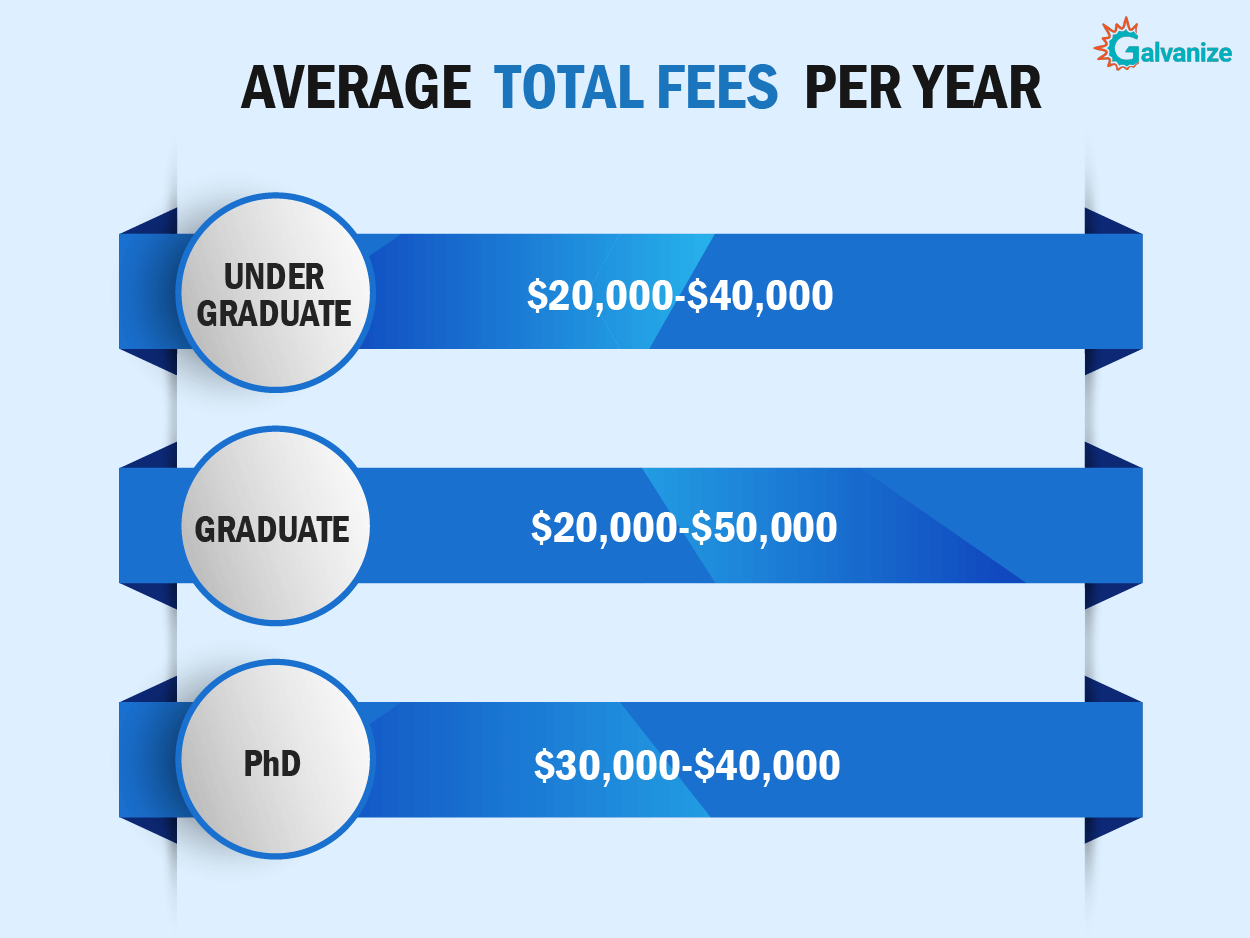
Other than Tuition costs, students will also incur living expenses that will be between $10,000 – $20,000 per year depending on location. Living expenses will cover Room and Board, Books and Supplies, Transportations, and Health Insurance.
To receive your visa documentation, universities require students to submit financial documents showing the availability of liquid funds for one year of tuition and living costs for studying in the USA.
Some universities will require these documents at the time of application, and students should plan for this in advance of submitting their application. Other universities will require these documents after receiving an admit. The sources of these funds are typically in the form of personal funds, sponsors’ funds, or loans.
2. What are the financial aid options available to study in US?
The United States is one of the most desirable destinations for international students. As you are aware, higher education institutions in the US are considered the best in the world.
While obtaining a degree may be expensive, international students are eligible for some scholarships to study in the USA. According to the Fulbright Commission, more than 600 American universities offer scholarships worth $20,000 or more to international students.
They are typically assessed on either academic merit, financial need, or extracurricular contribution. Financial assistance and scholarships can help international students achieve financial stability while pursuing their academic goals.
2.1. Student Loans
International students are eligible to apply for financial aid at their respective universities. Some of the financial aid alternatives available for international students are:
1. School Loans:
Some schools provide student loans to international students. Students can contact their academic advisor or their school’s financial aid office to learn more. (These loans incur an interest which has to be paid back.)
2. Private loans:
Some private lenders also provide loans to international students. Students can contact International Student Services or the Office of Financial Aid at their school to gather information. If you are interested in opting for loan options available in India, please contact us.
3. The International Education Financial Aid (IEFA) organization:
IEFA has partnered with the leading provider of international student loan programs to provide students around the world with financial aid options to fund their education abroad. Students can check IEFA’s website for information about eligibility and how to apply.
2.2. Scholarships and Grants
Many universities offer scholarships and grants for international students. Some departments and colleges within a university, partner with various organizations to support all students, including international students.
Students can contact their department and advisors to learn about these scholarships and grants.

Types of Scholarships
1. University scholarships
Most universities will offer some kind of financial aid for international students, so your institution of choice should be your first port of call when considering funding.
2. Financial scholarships
These scholarships are based on the financial need of the students. The majority of these are only available for US residents, but some universities will give out need-based scholarships to international students.
3. Merit scholarships
These scholarships are to help students who are either academically gifted, were top sports players in high school, or excelled in a community or entrepreneurial work.
4. Country-based scholarships
These scholarships are particularly targeted at students from developing countries.
5. Government-funded scholarships
The United States government offers many scholarship programs for international students, some of which are listed below.
6. Privately-funded scholarships
Sometimes private businesses or donors will fund scholarships for international students. These are also more likely to be targeted at developing countries and minority groups, or in specific areas of study.
7. Part scholarships
These can range from a small one-off payment the student can use towards their fees or a larger payment that is staggered to cover certain costs of going to university.
Students can check for scholarship details at these few websites – International Scholarships, College Board, Fast Web. When making plans to attend university in the United States, international students should anticipate high costs and explore opportunities to finance their education.
By addressing their financial needs, they will be more likely to ensure their academic success as well.
Types of Assistantships
While scholarships are fee waivers provided to students without any student service, assistantships are on-campus employment opportunities for students who provide their service for the university’s functioning.
Assistantships come with a wide range of benefits. It not only covers a part of your tuition fee, but also provides stipends, insurance, and other benefits as stipulated by the university.
This will vary from one university to another and from contract to contract. The maximum number of hours you can work is 20 hours on campus.
Let us look at the different types of Assistantships provided.
1. Teaching Assistantships
TA or teaching assistantships are provided to graduate students. Their duties would range from assisting students, checking their assignments, helping professors with daily activities, and other similar tasks.
In some universities, your tuition may be fully waived, yet it depends on the resources available and the benefits mentioned in your contract. Your pay and working hours depend entirely on the kind of work you are offered. Normally, the stipend would range from $550 – $1500 per month depending on your work hours and position held.
2. Graduate Assistantships
GA or Graduate Assistantships are for positions related to departmental tasks. Finding one of these more administrative-type graduate assistantship positions is similar to finding any other job – it takes networking, perseverance, professionalism, and sometimes just good timing. The GA also provides more or less the same benefits as the other assistantships.
3. Research Assistantships
This assistantship is commonly provided in research-oriented universities that have Ph.D. programs. The funds for research assistantships come from the research project under a professor.
The job typically involves programming, simulations, writing research papers, setting up labs, and helping professors with their research. Professors usually look at your skills and research experience before they offer an RA position.
3. Is it possible to get a 100% scholarship to study MS in US?
Obtaining scholarships might seem impossible for international students. While these opportunities exist, students should ensure that their profile stands out when applying for funding.
According to Meredith Twombly, Vice President of Admissions and Financial Aid at Clark University in Massachusetts
“A strong applicant will have demonstrated leadership and teamwork, strong letters of recommendation from teachers who know them and a consistently strong academic record which includes writing but also demonstrates follow-through and discipline.”
Your skillset can particularly boost your scholarship chances. Most universities prefer to have students who have excelled in various areas such as leadership roles, volunteering, taking up projects, and writing research papers. While these are not limited to these specific areas, it will be great if students can add more value to their profiles.
That said, we had two student profiles who were exemplary and had received full scholarships for their master’s programs. The first student had a strong research profile and had worked with the imminent personalities of her subject area.
The research area was in tune with the work done by the professors at the university, and she got accepted into the master’s program at the University of Texas at Austin with a full scholarship. Her overall profile along with her stellar GPA and test scores had made it possible for her to realize her dreams.
The second student, who was from the Biotechnology field, had a number of relevant projects, was active in volunteering, and participated in co-curricular activities.
With his exemplary profile, he was admitted into Miami at Oxford with a 90% scholarship. Building up your profile definitely takes time, however, you can achieve the best while doing so.
4. Scholarships for International Students
Scholarships and Financial aid are widely searched by international students worldwide. As we are aware, there are many organizations providing scholarships. Below are a few of the websites that are listed to make your search easier.
1. The College Board supports 7 million students each year as they prepare for college and also oversees the SAT college admission test. Their website offers scholarships and other financial aid and internship information for more than 2,200 programs.
2. International Student specifically provides a scholarship search for international students. Its comprehensive and searchable database of grants, scholarships, loan programs, and other information ensures that students from around the world have as many resources as possible to find ways to pay for college.
3. Fastweb provides access to 1.5 million scholarships worth $3.4 billion. Students create a profile and are able to keep track of their applications on the website.
4. Buddy4Study is a scholarship search engine for Indian students applying to schools in the USA and in other countries.
But the best way to search for scholarships is, of course, by using the resources available through the university’s admissions and financial aid office.
5. Scholarship competitions for international students
1. The Aga Khan Foundation International Scholarship provides scholarships to students from select developing countries who have no other source of financial help for their graduate studies. The scholarships are 50 percent grant and 50 percent loan.
2. The American Association of University Women offers fellowships for non-American women who want to earn a master’s or doctorate in the USA. Priority is given to women who can demonstrate the commitment to the advancement of women and girls, and the scholarship may be reapplied every year of the program.
3. The Civil Society Leadership Awards offers full scholarships for master’s students from specific countries who are dedicated to fostering social change.
4. Foreign Fulbright Student Program offers scholarships for graduate students from around the world (as well as young professionals and artists) to study in the USA.
5. International Student has a comprehensive and searchable database of grants, scholarships, loan programs, and other information for international students.
6. The Joint Japan/World Bank Graduate Scholarship Program provides comprehensive financial coverage, including tuition, a monthly stipend, airfare, health insurance, and travel allowance, to students from developing countries who have provided support to their home country’s development and who are applying for a development-related master’s program.
7. MPOWER Financing offers scholarships for international and DACA students. Its Global Citizen Scholarship Program has the broadest eligibility criteria. Moreover, it is offered throughout the year, and niche scholarships are also available.
8. The P.E.O. International Peace Scholarship awards scholarships to women from other countries who are earning their graduate degrees in the USA.
Chapter 4 : Top Universities in the USA and their Fees
1. Best universities in the United States and their fees
Each ranking organization measures institutions in different ways, using different criteria and weightages of ranking parameters.
These are the popular global university ranking institutions: The US News and World Report, Times Higher Education – World University Rankings, The QS World University Rankings, ARWU, or Shanghai Ranking.
Some of the common elements across the rankings are academic research output, expert opinion, and faculty-student ratio. Other variable parameters include learning environment, Employer reputation, Industry income – innovation, and international outlook among others.
Despite their differences, there is a level of consistency among these global ranking systems.
Best universities in the USA and their fees:
| TOP Universities in USA | UG Estimated cost per Year | PG Estimated cost per Year |
|---|---|---|
| Harvard University | $51,925 | $54,880 |
| Stanford University | $53,529 | $55,905 |
| Massachusetts Institute of Technology (MIT) | $53,790 | $53,450 |
| University of California, Berkeley | $43,176 | $26,544 |
| Princeton University | $51,870 | $53,770 |
| Columbia University | $61,850 | $50,496 |
| California Institute of Technology | $54,600 | $54,537 |
| University of Chicago | $59,298 | $64,241 |
| Yale University | $55,500 | $43,300 |
| Cornell University | $57,222 | $29,500 |
2. What are the Top Universities in the USA for MIS?
Each of the ranking systems discussed above also have subject-wise rankings. Subject-wise rankings available for a variety of sciences and engineering, and social science and MBA disciplines. The ranking of the program will vary by program and will change periodically. It is advisable to refer to the rankings before selecting programs for your application.
Top universities in the U.S. for MIS programs:
| University Name | Estimated Cost Per Year | Average GMAT score |
|---|---|---|
| Massachusetts Institute of Technology (Sloan) | $77,168 | 727 |
| Carnegie Mellon University (Tepper) | $68,000 | 687 |
| University of Arizona (Eller) | $32,065 | 659 |
| University of Texas--Austin (McCombs) | $54,924 | 704 |
| University of Minnesota--Twin Cities (Carlson) | $51,456 | 675 |
| Stanford University | $73,062 | 734 |
| Georgia Institute of Technology (Scheller) | $40,752 | 681 |
| Georgia State University (Robinson) | $23,544 | N/A |
| New York University (Stern | $74,184 | 721 |
| University of Maryland--College Park (Smith) | $56,646 | 643 |
3. What are the top MBA Colleges in the USA?
| Top 10 MBA Programs. ( US News Rankings) | ||
|---|---|---|
| University Name | Estimated Cost Per Year | Average GMAT score |
| Stanford University | $73,062 | 734 |
| University of Pennsylvania (Wharton) | $74,500 | 732 |
| Northwestern University (Kellogg) | $73,404 | 730 |
| University of Chicago (Booth) | $72,000 | 730 |
| Massachusetts Institute of Technology (Sloan) | $77,168 | 727 |
| Harvard University | $73,440 | 728 |
| University of California--Berkeley (Haas) | $64,656 | 725 |
| Columbia University | $77,376 | 732 |
| Yale University | $72,350 | 721 |
| New York University (Stern) | $74,184 | 721 |
4. Top Universities in the USA without GRE
The GRE is daunting for many applicants, but it should not be a deterrent to your university admissions process. While programs vary in their GRE requirement, here are some of the top universities that do not require the GRE for select programs.
For further verification of your specific program’s admissions requirements, please visit the program website or a Galvanize admissions counselor.
| University Name | Estimated Tuition cost per year |
|---|---|
| Saint Louis University, St. Louis, Missouri | $21,710 |
| University of Wisconsin Milwaukee, Wisconsin | $24,898 |
| University of Alabama,Birmingham, Alabama | $19,282 |
| University of Colorado Denver, Colorado | $20,755 |
| Adelphi University,Garden City, New York | $31,520 |
| University of Idaho,Moscow, Idaho | $29,112 |
| Montana State University,Bozeman, Montana | $15,418 |
| Auburn University,Montgomery, Alabama | $16,892 |
| California Lutheran University,Thousand Oaks, California | $19,665 |
| Marist College,Poughkeepsie, New York | $15,300 |
| Charleston Southern University, South Carolina | $8,250 |
| National University,San Diego, Los Angeles | $17,941 |
| Concordia University Chicago, River Forest, Illinois | $28,275 |
| Marshall University,Huntington, West Virginia | $24,518 |
| Rivier University,Nashua, New Hampshire | $10,206 |
| Monroe College,Bronx, New York | $15,624 |
| Duquesne University,Pittsburgh, Pennsylvania | $19,560 |
| DePaul University,Chicago, Illinois | $27,680 |
| Saint leo University,St. Leo, Florida | $10,260 |
Chapter 5 : VISA and Employment Opportunities in USA
1. How to apply for US Student VISA
Once you’ve been accepted, you will need to apply for your visa and schedule your interview. Generally, for undergraduate and graduate programs, international students require an F1 visa.
1.Request I- 20
The first step in the process is to request I-20s from universities that you’d like to attend. Typically, these universities will expect you to make this decision by the stated deadline or April 15.
2. Finalize I-20
Next, finalize one I-20 for your visa application
3. Pay the SEVIS i-901 fee:
The US government requires all international students to pay the SEVIS fee when applying for their visa. For F1 students, the fee is $350.
4. Fill the visa application DS-160:
It is the non-immigrant application form for temporary travel to the US. Once you’ve filled the form, be sure to print out the confirmation page with the DS-160 barcode number on it.
5. Pay the application fees and schedule your visa appointment:
For F1 students, you will be required to pay a fee of $160, known as the MRV fee. You will then need to schedule your visa appointment. You will schedule 2 appointments – Biometrics and visa interview. Make sure you do this well in advance, as the wait time to receive an appointment, changes on a weekly basis, depending on the incoming workload. You cannot schedule your visa appointment and interview on the same day. You need to attend the interview the day after the visa appointment.
6. Biometrics:
On the day of the appointment, be sure to carry your i-901 SEVIS payment confirmation, DS-160 confirmation page, application fee payment number, passport, a photograph, and your I-20. You will then be called for fingerprinting and to have your photograph taken.
7. Visa interview:
The visa interview will only last for a couple of minutes, where the interviewer will question you as to your intentions of traveling to the US and your plans for study. Be sure to answer honestly and confidently.
For more information please visit https://www.ustraveldocs.com/in/. Galvanize guides you through each step of the visa application process and even helps you prepare by means of a mock visa interview, to train you in the best way to answer frequently asked questions.
An F1 visa is issued to students to pursue their higher education in the US. This is issued after ensuring that the student has sufficient financial resources to fund his/her education. It can be issued up to 120 days before the start date of your course.
CPT is the Curricular Practical Training program that allows students to gain practical experience directly related to their field of study before they graduate. This can be in the form of paid or unpaid internships, but it must be related to a curriculum. However, note that if you work full-time ion CPT for 12 months, you will not be eligible for OPT.OPT is the Optional Practical Training program offered to F-1 visa students to allow them temporary employment related to their field of study for a period of 12 months after graduation. STEM students receive an additional 24-month extension on their OPT.
2. What are the employment opportunities in the US? When should you begin searching for a job?
What are the employment opportunities in the US? When should you begin searching for a job?
An F-1 student could work 20-hours per week on campus during the school year, and 40-hours per week on campus during vacation. One of the features that attracts International students to the US is the opportunity to work in their field.
Students can utilize both Curricular Practical Training (CPT) as well as Optional Practical Training(OPT) privileges to work off campus after receiving appropriate authorization. To seek employment further to this, individuals apply for an H1B visa.
An H1B visa is issued to employees who seek temporary employment in the US. The H-1B visa and status is initially valid for three years and can then be extended for another three years. To be eligible, the applicant has to be sponsored by an employer who will apply on behalf of the applicant.
The Career Services Center at your university is the best starting source for your initial job search. The staff can help to review your resume, prepare you for job interviews and assist you in finding available jobs through career fairs, various networking opportunities and alumni connections.
2.1. TIPS TO HELP WITH JOB SEARCH
Here are some tips to help you with your job search:
1. Plan Ahead:
You will need to start preparing in advance for your job search in the US after graduation. Make a list of potential employers large and Small, in the geographical area in and around your university and beyond. Be organized with your job search and maintain a spreadsheet and document your knowledge of as well as your applications to potential employers.
2. Get Involved:
It will be difficult to get a job or internship through strong grades alone. US employers value students with extracurricular activities, related hands-on experience, and leadership experience. See what transferable skills employers look for in candidates and the various ways you can contribute.
3. Research H1B Friendly Employers:
Be intentional about your job or internship search by researching which companies have hired international candidates in the past. Alternately, Have a Second Option. Expand your pool of opportunities by applying for positions in the US and in your home country (or perhaps a third country too). Explore where your education and experiences are in demand and be open to options you previously hadn’t considered!
4. Prepare US Style Application Documents – Resume & Cover Letter:
Make sure you know how to write a US style resume and cover letter and seek feedback from native speakers of English and the career counselors at the career center. Understand the requirements of the job and customize your letter to address your selling points that address their needs. In doing this, also address the larger vision, mission, and values of the company. Within 1 or 2 weeks of submitting your job application, call to ensure that they have received your application and request them for a possible interview date
5. Practice for your job interview:
While knowledge about the industry and company, and evidence of skills relevant to the job are important for the job interview, Strong English language skills, non-verbal communication skills and interpersonal skills are all crucial for success. The university is the best place to polish those skills by using opportunities to interact with classmates, faculty and friends in a professional manner. Becoming involved in professional clubs at the university will also help you enhance these skills. For the interview please wear professional attire like a business suit.
2.2. TOP JOBS IN THE US
Studying in the US is an excellent opportunity both in terms of developing your technical skills as well as for your personal improvement. Your exposure to a global community can greatly enhance your experience and help boost your career growth. According to the US Bureau of Labor Statistics some of the fastest growing occupations in the USA are information security analysts, and statisticians. According to industry sources as cited by Forbes magazine (2019), following are some of the best jobs in USA with median annual salary:
While the above is not a comprehensive list of available jobs, you will have to spend time researching your industry and companies to identify opportunities. The important thing to keep in minds is that as an international student you will have to find an employer who will sponsor your visa. Make sure that your skills match the requirements of the company and that your application conveys your unique selling points effectively. You may apply for several jobs over many months to land your dream job, and this process can be personally challenging. Use your professional networking skills online and offline to identify the right referrals, use job search engines to widen your search beyond your network, research your industry well to know available job opportunities .
3. What is work Authorization for International Students?
It is essential for international students to understand when and how they can start working off campus. Students need to be able to articulate their student visa work authorization options and their employment visa options to employers, as not all U.S. employers are experienced in hiring international candidates. Following are the opportunities that international students can utilize
- Curricular Practical Training (CPT) for off-campus internships during academic program
- Optional Practical Training (OPT) for post-graduation employment for 12 months
- STEM OPT extension for recipients of a STEM degree is 24-months
4. How many MS students from India get a job in the US?
The current US annual statutory cap on H1B category is 65,000 visas, with 20,000 additional visas for foreign professionals graduating with a Master’s or doctorate degree from a U.S. institution of higher learning. In 2019, the success rate of initial employment H1B petitions was 76% overall . While there is no data as to how many Indian students with US degrees have received a job, international students are always in demand owing to the multicultural aspect that the employers can bring into the workforce.
The US Citizenship and Immigrations Services publishes data on Approved H-1B Petitions by Employers, this dataset is a great starting point to find H1B friendly employers. According to this report, some of the best employers for H1B applicants are:
=
|
Top 50 Employers of H1B Visa Applicants in Fiscal Year 2018 Source: US Citizenship and Immigrations Services |
|
| Employers | # of H1B Approval |
|---|---|
|
AMAZON COM SERVICES INC |
2396 |
|
MICROSOFT CORPORATION |
1265 |
|
INTEL CORPORATION |
875 |
|
GOOGLE LLC |
782 |
|
APPLE INC |
708 |
|
ERNST & YOUNG US LLP |
697 |
|
DELOITTE CONSULTING LLP |
694 |
|
FACEBOOK INC |
661 |
|
TECH MAHINDRA AMERICAS INC |
594 |
|
TATA CONSULTANCY SVCS LTD |
527 |
|
COGNIZANT TECH SOLNS US CORP |
500 |
|
ACCENTURE LLP |
357 |
|
WAL-MART ASSOCIATES INC |
339 |
|
CISCO SYSTEMS INC |
327 |
|
JPMORGAN CHASE & CO |
322 |
|
CUMMINS INC |
310 |
|
IBM CORPORATION |
310 |
|
CAPGEMINI AMERICA INC |
277 |
|
WIPRO LIMITED |
275 |
|
DELOITTE & TOUCHE LLP |
267 |
|
L&T TECHNOLOGY SERVICES LIMITED |
251 |
|
AMAZON WEB SERVICES INC |
248 |
|
BLOOMBERG LP |
226 |
|
MCKINSEY & COMPANY INC US |
213 |
|
THE LELAND STANFORD JR UNIVERSITY |
209 |
|
HCL AMERICA INC |
203 |
|
GOLDMAN SACHS & CO LLC |
195 |
|
BANK OF AMERICA NA |
180 |
|
UNIVERSITY OF MICHIGAN |
178 |
|
ORACLE AMERICA INC |
175 |
|
MPHASIS CORPORATION |
173 |
|
LINKEDIN CORPORATION |
167 |
|
NVIDIA CORPORATION |
163 |
|
AMAZON CORPORATE LLC |
159 |
|
UBER TECHNOLOGIES INC |
157 |
|
HEXAWARE TECHNOLOGIES INC |
152 |
|
LARSEN & TOUBRO INFOTECH LIMITED |
152 |
|
ADOBE SYSTEMS INCORPORATED |
149 |
|
MINDTREE LIMITED |
149 |
|
SYNECHRON INC |
147 |
|
A2Z DEVELOPMENT CTR INC D/B/A LAB |
145 |
|
COMPUTER SCIENCES CORPORATION |
143 |
|
MAYO CLINIC |
141 |
|
CERNER CORPORATION |
132 |
|
THE MATHWORKS INC |
129 |
|
COLUMBIA UNIVERSITY |
128 |
|
NTT DATA INC |
128 |
|
PAYPAL INC |
128 |
|
TESLA INC |
128 |
|
GENERAL MOTORS COMPANY |
127 |
Chapter 6 : Campus life in the USA | Study in USA Guide
Lets look into all the aspects of the life in USA you would be undergoing while you study there. It is not always easy to start afresh in a new country where we meet people from various countries and backgrounds. As an international student, living in the US might come as a cultural shock to you. But with time, you can slowly try to understand how the system works and immerse yourself in the new culture. The culture gap can be bridged by meeting new people and interacting with them at your own pace.
Table of Contents
1. How is life in the US for Indian MS students?
It is not always easy to start afresh in a new country where we meet people from various countries and backgrounds. As an international student, living in the US might come as a cultural shock to you. But with time, you can slowly try to understand how the system works and immerse yourself in the new culture. The culture gap can be bridged by meeting new people and interacting with them at your own pace.
A diverse culture is what makes the US stand apart. Observe how others interact with each other and act in accordance with it. Try to touch base with your family and friends from home often to minimize culture shock. Get in touch with the international student services in your own university to find people who share your interests and want to explore the new place just like you. This will help you be at ease and quickly integrate into your new culture.
The education system in the US is more interactive and hands-on. You may find that it is easier to learn through this system of demonstration and visual learning than the Indian education system that we are more accustomed to. Students have to maintain their full-time status and enroll for a certain number of credit hours each semester. You can interact with your classmates as well as your professors to see how to learn and turn in assignments. The grading system is cumulative, and every project, assignment, quiz, and test will be considered towards your final grade.
Finding your accommodation and maintaining your expenses could be a challenge. You can opt to live in apartments on a sharing basis. This will bring down the cost of living and you will be able to save on your expenses. Staying at a walkable distance will help you reach your classes on time and also utilize the resources on campus. To cut down on expenses, you could also learn basic cooking and prepare fresh food at home. This will help fine-tune your skills and also save money.
Time is very important to Americans. They go with the term ‘Time is money’. If you make an appointment, ensure that you arrive 15 minutes before your scheduled time. Submit your assignments on time and engage with your team members as needed when presentation tasks are assigned. Ensure that every task is written down so that you can complete the same.
Living in a new country is not easy. But with time and effort we can make use of the resources and learn to appreciate a new culture and place.
2. What should an international student know about the U.S.?
International students are welcomed warm-heartedly in the US. Each US university has an international student office where students can reach out and receive guidance in adapting to US university life. Several events are organized by the International Student Services office for international students. Indian student associations are also a part of the student office.
Finding Accommodation and developing ties:
Indian students have the option of staying in dormitories or in private accommodations. As a student, it will be best to stay near the university campus at a walkable distance or near the university shuttle stop. In the first year, it is advisable to share accommodations and understand how things work in the new country. Most Indians often live together in shared accommodations. While this has certain advantages, it should not come at the expense of cross-cultural ties. Do make an effort to meet, work, and travel with people from different ethnicities and cultures. The US offers a great diversity of people and this is an excellent opportunity to develop global networks while learning about other cultures and traditions. Ensure that these opportunities and resources are tapped into.
Learn Basic cooking:
Your time abroad would be a great time to develop some basic cooking skills. Cooking on your own will save money, and will definitely help you cut unnecessary expenses. Learn how to cook rice, dal and simple gravy. This will satisfy your cravings to eat Indian food. Since Indian spices are not commonly found in smaller cities, it is advisable to carry spices and other culinary needs while you travel to the US.
Medical Insurance
It is important to have medical insurance when traveling abroad. While most universities provide their own medical insurances, make sure that you research other acceptable insurances. Without medical insurance, it is impossible to get treated by a doctor in the US.
Conversing with Americans and sharing personal information
Indians tend to speak faster than the average American and it can be difficult for them to follow the conversation. Speaking slowly and clearly will resolve the communication barrier. Remember to always protect your information, including social security numbers and credit card numbers. Legitimate organizations will never ask for private information such as ATM PIN or other bank details.
2.1. Money matters :
Social Security Card :
A Social Security Number (SSN) is issued to track your earnings over a lifetime. It is not a work permit, but you must apply for an SSN to be employed. To apply for an SSN, the Social Security Administration requires evidence that you:
- Are eligible to work in the U.S.
- Are a full-time student
- Have received a formal offer for on-campus employment, OR
- Have been authorized for off-campus employment through Curricular Practical Training, Optional Practical Training, or Academic Training.
The Administration will verify your immigration documents and status with Immigration before issuing the Social Security Number. Wait 10 business days after arriving in the U.S. to apply for the SSN. To apply for an SSN, contact your International Student’s office.
Open a local bank account :
You will need a checking account to be able to pay bills, rent, deposits for housing, etc. and to build your credit history. Ideally you want to choose a bank that is easily accessible to you either on or near your campus. Whether you choose a private bank or a not-for-profit credit union, to open an account you will need:
- Your passport, with the relevant student visa,
- Secondary photo ID – often a driver’s license or student ID card,
- Proof of residence,
- Proof of enrollment at your university, and
- A minimum deposit.
Be sure to give your Social Security Number to the bank as soon as you receive one.
2.2. Transportation:
Some students may live on-campus, while others opt for off-campus housing. Whichever you choose, you will need to get around campus for your classes, and the city for your necessities and entertainment. Some students may opt to buy a used car, but this is not always feasible soon as you arrive in the USA. So, it is important to familiarize yourself with the public transportation system.
Buses :
Your student ID can help you use the extensive bus service at a reduced rate. There are also apps you can use to keep track of the bus schedule. Some campuses even have their own buses that shuttle students to various buildings around a large campus.
Subways/Trains :
Whether you take the BART, PATH, SEPTA, MARTA, Washington Metro, or any other will depend on your university’s location. If your university is located in one of the major cities in the US, the subway rail system would be one of the easiest ways to get around. And the Amtrak is a great way to explore the country. Check for student discounts before purchasing tickets or passes.
Taxis/Ridesharing :
Taxis are pretty expensive, especially for an international student on a budget. So if you want to ride one, try to limit it to emergency situations. On the other hand, there are still several ridesharing services available, such as Uber. These are often used by college students to get around the city.
Bicycles:
Probably the healthiest and easiest mode of transportation! Bicycles can be very useful for moving around campus. So if you are comfortable cycling, then investing in a bicycle is a campus must-have. And remember to wear a helmet!
The transportation option you choose depends a lot on where you are living and how often you need to travel. So plan ahead and look into your accommodation and other details before deciding on a mode of transport that works for you.
2. Campus Life In America
3.1 CULTURE SHOCK
Moving to a new place is always intimidating, especially if you are moving somewhere that is distinctly different from your home environment. As international students settle into their new schedules, move into their new rooms, meet new people, and are exposed to the new culture, it is natural to feel overwhelmed. However, there are ways that a student can tackle this “culture shock,” and smoothen their transition into their new routines.
Go out and socialize :
It can be extremely tempting to just stay in your room and not go out, especially when you are unfamiliar with the area. However, that is exactly why you should go out to talk to people and familiarize yourself with your surroundings. Try and find people who share the same classes as you, or live in your housing unit. This will help you feel more comfortable and confident during your stay on campus.
Get involved :
Universities always have dozens of events, clubs, and other extracurriculars throughout the year. Find your niche and get involved. This could be something that would help you professionally or simply something you are interested in. However, if your program is too intensive to include extracurriculars, then exercise can do wonders in helping you feel better. Incorporating exercise into your routine can help you feel healthy, and going out for a run is always a great way to make new friends.
Gain Cultural exposure :
The best way to feel more comfortable about living in a foreign country is to learn as much as you can about it. This doesn’t have to be limited to theoretical knowledge. Explore the city that you are living in when you get a break. Request your new friends to show you around. You may find that while your new environment might not be home, it is still a pretty great place.
Be patient :
It is important to keep an open mind. While there might be many practices in the US that you might not feel comfortable with, don’t be quick to judge. You don’t need to adopt the American lifestyle, but you can still adapt to it. Above all, give it time. It is always difficult in the beginning. But things will get better if you just wait. With time, as you become more familiar with your new life, your comfort level will increase and you will learn to love it.
Seek help :
Don’t be afraid to admit that you need help. Many students face depression, but it takes courage for one to admit it and do something about it. Talk to your campus counselor. Keep in touch with your family back home, as their support would be invaluable to you during this time. Also, try to find other international students, even those who are not from your home country. They would have gone through the same process as you, and hence, would be able to help you navigate it better.
All in all, stay positive! Studying abroad is a great experience, not just for your career, but also for your life. Not everything might be great at the beginning, but view it as a learning experience. Every cloud has a silver lining, so just wait until you find yours.
3.2 SORORITIES AND FRATERNITIES:
A sorority or a fraternity is a community of women or men, respectively, who share similar aspirations or interests. They are social organizations that aim to contribute positively to student life on campus, through volunteering work, charity projects, or other local community events. These organizations are often termed as “Greek” as they are named after Greek alphabets (Eg: Alpha Chi Omega, Kappa Alpha Psi), which represent the values that each community stands for.
Though it is usually undergraduate students who choose to “rush” a Greek organization, there are quite a few universities that allow graduate students to apply to a sorority or fraternity as well. Every school has its own set of rules and limitations, and it is important that you review these carefully if you wish to be a part of Greek life.
There are several benefits to joining a sorority or a fraternity. Apart from the strong network that you can build and the opportunity to be involved in several diverse events and programs on campus, Greek life gives you a chance to develop your leadership and interpersonal skills. These skills can be listed in your resume, and have greater value since you can back them with the fact that you were a member of a Greek organization. Moreover, Greek organizations are supported by their wide network of alumni members, who can help you when you are applying for jobs or are looking for career opportunities, as they have navigated these waters before themselves. Apart from this, sororities and fraternities teach their members to exhibit a certain standard of etiquette and behavior, and joining one is a great chance for you to work on your personal presentation.
But while sororities and fraternities are a great way for students to build lifelong connections and experience the best of college life, there are some things you need to consider before deciding to “rush.” It should be noted that membership fees for Greek organizations are usually quite high. While costs differ depending on university and chapter, you will have to pay chapter dues and a one-time initiation fee. If you are part of a national Greek organization, then you will also have to pay national yearly or termly dues. Apart from this, there is also the cost of participating in social events organized by the chapter, as well as the rent of the Greek house. It should also be noted that Greek life requires a lot of time and dedication, and schools usually insist that sorority or fraternity members maintain a minimum GPA. So if you are enrolling for an intense program that requires a lot of time in study and research, you might want to plan out how you are going to manage your time
3.3 SAFETY
Safety is an important parameter to select your destination. Here are some of the safest cities in America by size, and more data is available here:
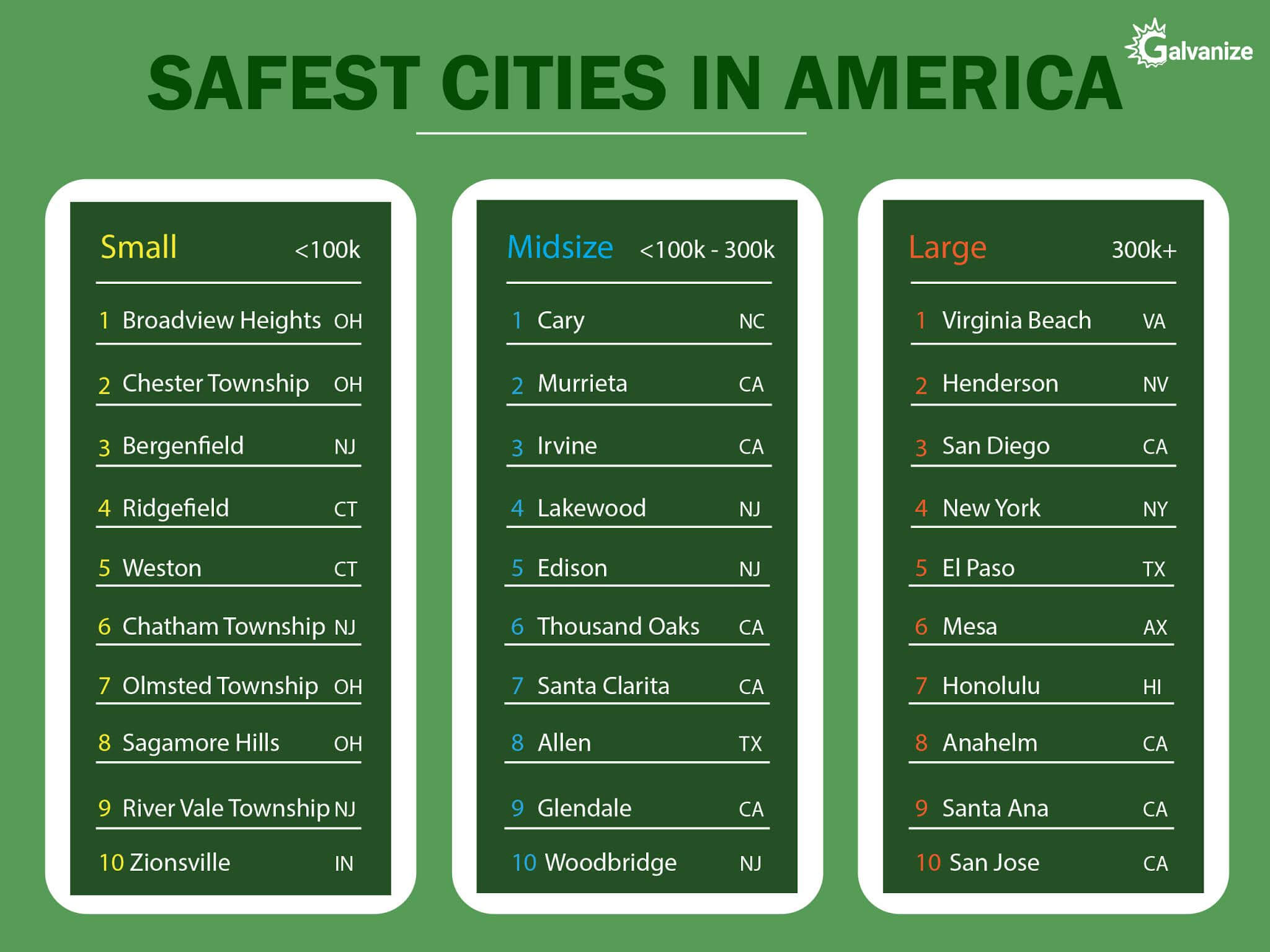
The safety of students is extremely important to the universities that typically contract private security companies to be in charge of campus safety. Rest assured, universities have taken all the possible steps to ensure that each and every one of their students have the best and the safest experience during their stay on their campus. However, off-campus, students are still responsible for themselves and can take certain steps to protect themselves and further ensure their safety:
Do your research :
The easiest and most important way to stay safe in any situation is to be prepared. Don’t wait until after you have arrived in the US to gather information. Once you have decided on your university and have accepted your admissions offer, work on acquiring as much knowledge as you can about the place where you will be spending the next few years of your life. Do your research on the location, the area where you will be staying, the transportation systems, etc. Being equipped with this knowledge will not only help you feel safer and more comfortable on arrival, but it will also ease your transition into the foreign atmosphere.
Stay vigilant:
Always keep an eye on your surroundings and on your belongings. This is especially crucial when you have just arrived, and are still unfamiliar with the environment. Make sure that you keep your passport, wallet, and other important items close at hand. Even after you have joined the university and have settled in, make sure that you always keep your valuables in a safe place, preferably under lock and key. Never reveal your card number or important access details to anyone. Be especially careful after dark, even if you are just walking across campus. Take steps, if possible, to avoid traveling or moving outside your quarters at night. Even in the daytime, always keep an eye and ear open to observe your surroundings and be aware of what is happening around you.
Emergency protocol:
Memorize the university’s campus security number, and keep them on speed dial if possible. Since you are in a foreign country, learn the emergency numbers of the US, just in case. Go through the university’s emergency protocol systems, and ensure that you are aware of what must be done in such a situation. Try to keep at least one of your trusted friends informed of your whereabouts, especially if you live outside campus or are traveling far.
Be careful :
Overall, it is important to just be careful. Studying abroad can be an incredible, life-changing experience, provided that you are wise in your decisions and are not reckless. Keep your doors and windows locked at night, and don’t allow people into your building or your room if you do not know them that well. These are basic safety tips that you need to follow in any country, more so in a place you have never been to before. It is easy to get excited and overwhelmed by the new experiences and people you will encounter, but always keep a clear head and think before you make any decision.
Remember, too much is never enough when it comes to staying safe.
Liked the article “Life in the USA”. Comment your opinions down below! And read more admission related blogs here : Admissions blog page
Chapter 7 : Application Process | Study in USA
1. Application Process for US Universities | How to apply?
The application process for US universities typically begins at least one year prior to the start of the program. The application deadlines vary by university, but university programs typically have early deadlines around September – November, Regular deadlines between December – February, and late deadlines between March – June.
Most documents are standard, such as your resume, Statement of Purpose and Letter of Recommendation. However, some universities might require additional documents such as diversity statements or scholarship essays. Go through the university website carefully to understand its specific requirements.
Usually, the checklist for your application process will look something like this:
-
Resume
-
Academic Transcripts
-
Statement of Purpose
-
Letter of Recommendation
(2-3, from professors or work supervisors who can attest to some of the claims made in your SOP)
-
Standardized Test Scores
-
English Proficiency Scores
-
Financial Certificate
(A document that details your funds and proves that you can finance your education. It has to be signed by your guardian or financial provider.)
-
Passport
(You will need to upload a scanned copy of your passport)
-
Filling out the application itself – online
-
Application Fee
($20-$90, depending on the institute. Some may offer application fee waivers. Others, you may contact the university to enquire about application fee waivers)
With so much to do, and with requirements varying from university-to-university, the process can be overwhelming. Thankfully, we have trained professionals from reputed universities who can guide you through this process. From choosing the right university to crafting the perfect SOP to preparing you for your visa interview, these professionals can help you because they have graduated from top schools themselves.
Chapter 8 : Top courses to study in the USA
1. Which is the right program for you?
If the US is the right place for you, then begin with finding the right program that fits your goals. The US Department of Education has more than 4000 post-secondary institutions listed (U.S. News), which provide a host of programs that are both general and specialized.
Considering the innumerable options in every field of study, it’s safe to say that there’s something for everyone. You may choose a program based on a variety of factors.
For example, you may be more research oriented and may opt for a thesis-based program, and choosing between Data Science, or Machine Learning may depend on your technical competence and interest. The choice is very personal based on your interest, skills sets and career goals.
The Admission Counselling team at Galvanize can help you shortlist the best universities to suit your goals.
What are the various options of study?
These are associate degrees, bachelor’s degrees, master’s degrees, and doctoral degrees.
| Degree | Duration | Common sub-types of degree |
|---|---|---|
| Associate | 2 years |
AA (Associate of Arts) AAA (Associate of Applied Arts) AS (Associate of Science) AAS (Associate of Applied Science) |
| Bachelor’s | 4 years |
BA (Bachelor of Arts) BS (Bachelor of Science) BPhil (Bachelor of Philosophy) BEng (Bachelor of Engineering) BDes (Bachelor of Design) BSN (Bachelor of Science in Nursing) BSPA (Bachelor of Science in Public Affairs) BArch (Bachelor of Architecture) BBA (Bachelor of Business Administration) |
| Masters | 1-2 years |
MA (Master of Arts) MS (Master of Science) MPhil (Master of Philosophy) MPA (Master of Public Administration) MBA (Master of Business Administration) MPH (Master of Public Health) LLM (Master of Laws) MFA (Master of Fine Arts) MLA (Master of Arts in Liberal Studies) MEng (Master of Engineering) MArch (Master of Architecture) MEd (Master of Education) |
| Doctoral | 2 years |
PhD (Doctor of Philosophy) DBA (Doctor of Business Administration) EdD (Doctor of Education) MD (Doctor of Medicine) JD (Doctor of Jurisprudence) DProf (Doctor of Professional Studies) DArch (Doctor of Architecture) |
Apart from these, several universities also offer dual or joint degree programs. In a joint degree program, credit from a single course may count toward both degrees. Your degrees must be conferred simultaneously, upon completion of degree requirements for both programs, e.g. MS Computer Science/MBA. Combined or accelerated degree programs allow students to earn a bachelor’s + master’s (4+1) studies in a specific field. The type of program you choose will depend on your learning and career goals.
2. What are the top major Fields of Study and popular Programs?
Areas of study
While there are dozens of specific and generalized areas of study offered by US universities, the top major fields of study are:
Most popular programs
There are many popular courses which are favored by international students. Here is a report presented by the IIE on the most commonly chosen majors by international students:
3.STEM Courses in the USA
What are the stem courses in the USA?
STEM stands for Science, Technology, Engineering, and Mathematics. The STEM classified fields typically include programs that emphasize courses containing engineering, biological sciences, mathematics, and physical sciences, or a related field involving research, innovation, or development of new technologies.
Students who choose a STEM field of study are eligible for STEM-OPT extension. Eligible F-1 students with STEM degrees who finish their program of study and participate in an initial period of regular post-completion OPT (often for 12 months) have the option to apply for a STEM OPT extension.
This STEM OPT extension allows the student an additional 24-month to maintain off-campus employment in the United States. Here you will find the Department of Homeland’s STEM Designated Degree Program list.
4.In Demand Courses in USA
Which are the best courses to study for a good job abroad?
According to the PayScale college salary report for 2019, the top 10 majors which provide the highest paying jobs are:
- Applied Economics and Management
- Petroleum Engineering
- Operations Research
- Political Economy
- Actuarial Mathematics
- Electrical Engineering & Computer Science (EECS)
- Electrical Power Engineering
- Business Analysis
- Pharmacy
- Aeronautics & Astronautics
This by no means implies that other majors or degrees have low employability. This list is to only give you insight on which domains are providing the highest paying jobs.
Related Blogs:
Other Useful Links:
- [FREE Admissions Email Course] World’s Top Admissions Consultants have Built this Course to Get You into Top High Schools of your choice!
- [Galvanize Events] Attend Galvanize Powered Webinars for FREE.
- Get Profile Evaluation For Free By Alumna Of University of New Mexico, USA
- [FREE GRE Email Course] Discover the Hidden Tips & Strategies Recommended by the Pros to Dominate the GRE.
- [GRE App] Get the most awesome GRE practice app with 100’s of GRE style questions, excellent explanations, GRE Score Predictor & more!
- [Vocab App] The Ultimate Vocabulary Builder is a unique learning tool: far from being forced to study a long and boring list of English words, here you will experience a gamified vocabulary journey.
- FREE GRE Sample Test
